Content
(+ care tips)
The owners of six hundred square meters always have the same question: how to combine business with pleasure? After all, I would like to have both fruit trees and decorative ones. And there is not enough space ... So hazel is just what you need! Even ordinary varieties with green leaves look very elegant on the site. Especially in autumn, when their crowns are painted in all sorts of shades of yellow and red. And then there are varieties with purple leaves!
In addition, the fruits of this shrub are very tasty and healthy: they are the most nutritious of all nuts and even more nutritious than fish and meat!
In general, such a plant should be on every site.
10 varieties for the middle lane At the moment, 19 varieties of hazel (hazelnuts) are listed in the State Register of Breeding Achievements. Nine for the southern regions. And the other ten are displayed just for the middle lane.
Academician Yablokov. A very beautiful variety with red leaves. Bushes up to 3.7 m high. Productivity is high - 4–5 kg per bush. Taste rating - 4.5 points (out of 5 possible).
Ivanteevsky red. In summer, he also has red leaves, but in autumn they ... turn green. Bushes up to 4.5 m high. One plant can collect 1–2.2 kg of nuts. Tasters estimate their taste at 4 points.
Kudrife. A variety with beautiful pinkish-red leaves. Bushes 3.5 m high. Productivity - 1.5-2.8 kg. Taste - 4.5 points.
Moscow early. This variety also has red leaves. The bushes are low, up to 3 m. Productivity is up to 3 kg per plant. Taste rating - 4.5 points. Moscow ruby. A very decorative variety - the leaves and even the shells of the fruit are bright crimson. Bushes are high, up to 4.5 m. Productivity - 3 kg per bush. Taste score - 4.3 points.
It is the main pollinator for other varieties of hazelnuts.
Firstborn. The leaves of this variety are red. Plants up to 3.5 m high. Productivity is high - 4–5 kg per bush. Taste - 4.5 points.
It is a good pollinator for red-leaved hazelnut varieties.
Purple. Its name fully reflects the color of the leaves - they are dark purple in color. Bushes up to 3.5 m high. Up to 3 kg of nuts can be harvested from one plant. Taste rating - 4.6 points.
It is a good pollinator for hazelnuts with green leaves.
Sugar. One of the most beautiful hazelnuts - both the leaves and the nut wrappers are colored dark cherry. Bushes 3–3.5 m high. Productivity - up to 3-4 kg per plant. Taste - 4.5 points. In terms of oil and sugar content, it surpasses all other varieties!
Tambov early. It is the only cultivar for the middle lane with green leaves. The height of the bush is up to 4 m. Productivity - 4 kg per plant. Taste rating - 4.5 points.
Confession. This variety has red leaves in summer, and turn green by autumn. The bushes are low, only 2.5 m. Up to 3.5 kg of nuts can be harvested from one tree. Their taste is excellent - tasters give them 4.8 points. This is the most delicious hazelnuts for the middle lane!
Planting secrets It is better to plant hazel along the borders of the garden plot according to the scheme: 4x4 or 3x3 m.The planting holes are dug 80 cm wide and 50 cm deep.However, there is one little trick: it is useful to add a little soil taken from under the old hazel into the hole - in it there are special mushrooms that live on the roots of hazel. They will help a young plant to take root in a new place faster.
Ideal hazel seedlings should have 2–4 branches 30–50 cm long and a good lobe of roots. Before planting, they are pruned to 25-30 cm. The branches are shortened to 20-25 cm.
After the pits are covered with earth, the plants are watered - 2 buckets each. And the trunks are mulched with peat or humus with a layer of 3-5 cm.
Care Tips Hazel is very fond of moisture, so the first year it must be watered once a week - 2-3 buckets per bush. And be sure to weed out the weeds, otherwise they will clog the young plants. The trunk circles at this time should be constantly mulched.
By the way, the roots of hazel are located superficially, so loosen the ground very carefully, no deeper than 5–8 cm.
Under young bushes, once every 3 years, they bring in a bucket of humus.
Under fruiting plants every 2-3 years (in the fall for digging) add: half a bucket of humus or compost, 4 tbsp. tablespoons of double superphosphate and 1.5 tbsp. tablespoons of potassium salt. And in the spring, before bud break, 2 tbsp is poured into the trunk circle. tablespoons of ammonium nitrate or urea.
Form a hazel bush in 6-10 trunks. And at the age of 20 they begin to rejuvenate: 2-3 old trunks are cut annually, and new skeletal branches are formed from strong young shoots.
IMPORTANT!
In order for the hazelnut to give the maximum yield, 3-4 varieties must be planted side by side. And among them there must be at least one green, because red often form only female flowers. And if male earrings do appear, then their pollen is usually sterile.
Alexey VOLODIKHIN, agronomist
Material prepared
specialist of the Association of Russian Gardeners
Dorokhova E.V.
In preparing the article, materials from the Internet resource were used
www.ukr-nuts.org
Hazelnut and hazelnut varieties 
Aurea (Common hazel)
Aurea (Common hazel) - it is a large shrub up to 6 m high and wide. The crown is wide with numerous vertical trunks. Over the years, the crown becomes umbrella-shaped. It grows slowly at a young age, later faster. Flowers - graceful yellow dangling earrings. The fruits are round or oblong nuts. Edible. Leaves when blooming are golden-yellow, lemon-green in summer, turn yellow in the shade, large up to 1 2 cm long. Reaches the best development in sunny or semi-shady areas. It bears poorly in dense shade. Recommended for gardens and urban greenery as a color accent. No. 4219 The green-leaved variety N 4219 is also interesting. It has a cupped bush with burdock leaves and huge (26x24x21mm) nuts.
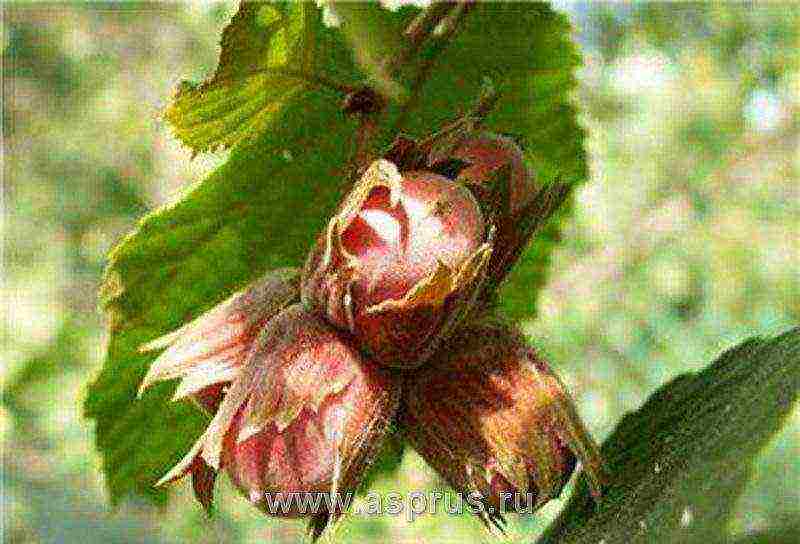
Adyghe 1
Adyghe 1 Seedling from free pollination of the local form. Received from the Kuban State Agrarian University on a personal plot in the Teuchezhsky district of the Adyghe Autonomous Region. Second: N.A.Tkhagushev. Early middle (third decade of August) ripening period. It is characterized by high frost resistance, relative drought resistance, little damage by pests and diseases. The average yield is 22.1 c / ha. On the Krasnodar nut-bearing cultivar plot, the average yield left 7.1, the maximum - 16.7 c / ha. Universal purpose. A bush of medium growth with a crown of medium density, about a round shape and geniculate, olive-yellow, about downy shoots. Fruits with an average weight of 1.7 - 2.1 g, broadly rounded, rounded - oblong, collected in 3 - 4, less often 5 - 8 pieces. The wrapper is whole, slightly longer than the nut. The shell is thin, light brown with strong fluff at the top. The kernel is full and dense. Kernel yield 49.3%, fat content 65.6%. Tasting score 3.9 points. On the state test since 1967. Included in the state register in 1 973 for the North Caucasus region. Zoned in the Krasnodar Territory and Kabardino-Balkaria. Advantages: Differs in high frost resistance, relative drought resistance, little damage by pests and diseases.
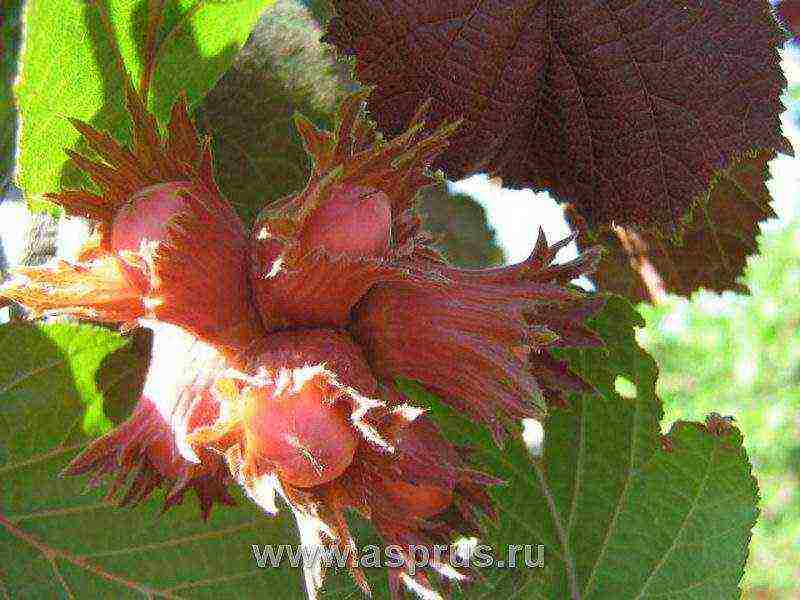
Academician Yablokov
Academician Yablokov Obtained by crossing hazelnut 86 and Trebizond. Separated from the A.S. Yablokova at the NPO for walnut growing "Funduk" of the All-Russian Research Institute of Forestry and Forestry Mechanization. From the hybrid fund of red-leaved hazelnuts, the most valuable were allocated to the elite. A medium-sized bush with a height of 3.5 - 3.7 m, a beautiful bowl-shaped. Leaves and shoots are red. The plants of the variety are very beautiful.True, at the beginning of the season, due to the dark brown color of female inflorescences, they look frozen, but by the middle of June many densely tied raspberry nuts appear on the bushes, collected in seedlings of 7 - 1 2 pieces. Differs in abundant formation of fruit twigs. Nuts are large, elongated acorn-shaped (25x17x17 mm), beautiful - dark brown stripes appear against a lighter brown background, the mass of a nut without a plyus is 2.5 - 3.4 g. The kernel yield is 54 - 56%, the fat content is more than 65%. It grows and bears fruit both in the middle zone of the country and in the south. In size and appearance, the fruits resemble acorns. The plant gives annually up to 10 kg of nuts per bush. Late ripening. They ripen in late September - early October. Due to a too thin shell, the nuts can be severely damaged by the weevil. Average winter hardiness - male inflorescences and annual growth freeze slightly. Female inflorescences can withstand spring frosts up to 6–7 ° С. Therefore, a pollinator was selected for him - hazel of the varieties Tambovskiy Ranniy and Tambovskiy Pozdniy, Pervenets. With the artificial pollination of female Hazelnut flowers of the Akademik Yablokov variety with pollen of the Tambovsky Pozdny hazelnut variety, up to 1 00% of the useful ovary is obtained. Tasting score 4.5 points. State test since 1975. Included in the state register in 1994 for the Central, Central - Black Earth, North - West, Middle Volga and North Caucasian regions. Recommended for Central (Bryansk region, Kaluga region, Moscow region, Ryazan region, Tula region), Central - Chernozem (Belgorod region, Voronezh region, Kursk region, Lipetsk region, Oryol region, Tambov region), Northwestern (Kaliningrad region ), Srednevolzhsky (Penza region) and North Caucasian (Rostov region, Kabardino - Balkarian Republic, Krasnodar region and the Republic of Adygea, the Republic of North Ossetia, Stavropol Territory and the Republic of Karachay - Cherkessia). The variety is winter-hardy, bears fruit abundantly and annually. Disadvantages: Average winter hardiness; in severe winters, annual shoots freeze. This hybrid bore fruit well already at a young age, but male earrings did not form on it until the age of 22.
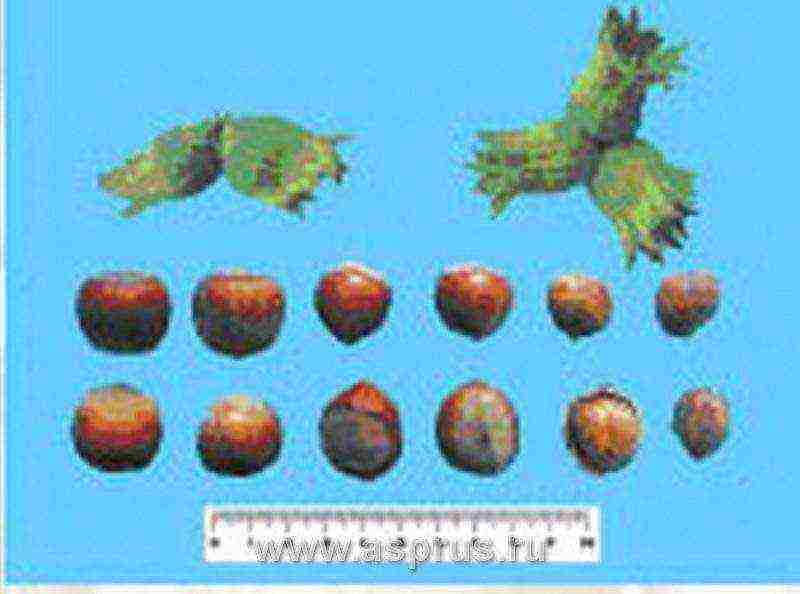
Anakliuri
Anakliuri local Georgian variety, which is obtained by folk selection. This variety is found in all regions of Georgia, but among the varieties widespread in Megrelia and Abkhazia, both quantitatively and qualitatively takes the first place. In Western Georgia it ripens from 15 to 20 July, and in the Eastern regions of Georgia from 15 to 20 August. This variety is relatively hardy enough without harmful diseases. The variety is characterized by fast growth. The crown is pyramidal. The growing branches are yellowish in color and covered with fluff. The leaves are rather large, rounded, thick and rough, dark green in color. The cover is much longer than the fruit (nut). When ripe, the fruit is easily released from the cover. The fruit has a slightly flattened round shape, brown in size 21x21x19 mm, the shell wall thickness is 1.2 - 1.6 mm. The core completely fills the shell. Fruit weight is on average 2.5 - 2.9 grams. The core is 48 - 52% by weight, fat content - 57 - 67%. One bush gives 7 - 9 kg.
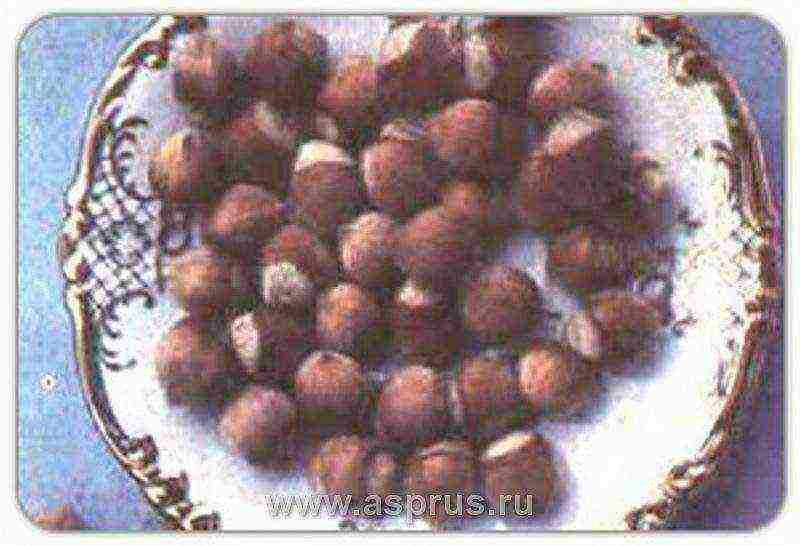
Ata - baba
Ata - baba Bushes 1.0 - 4.2 m in height. Fruits are 3 - 6, sometimes 1 - 2. The wrapper is 2 times the length of the nut, which has a flat - rounded shape, 1.7 - 2.0 cm in length and 1.4 - 1.8 cm in diameter. The shell is 0.75 mm thick. Walnut weight 2.5 g. Kernel 52%, fat content 68.22%. Nuts ripen in September. Give birth to 15 - 16 kg per bush. At the Zakatala strongpoint, bushes at the age of 11 yielded 7 kg each, and some of the bushes - 25 kg each. The Ata-baba variety is widespread in the walnut regions of Western Azerbaijan, where it occupies 90% of the area of all hazelnut orchards. In one Kutkashensky region, this variety occupies about 800 hectares. Ata - baba Local Azerbaijan variety. Late ripening. Resistant to pests and diseases.Weakly affected by powdery mildew. It begins bearing fruit for 4 years. Average yield 9.5 c / ha. Universal purpose. A vigorous shrub with a spherical, slightly flattened crown. Fruits are very large, weighing 2.5 - 3.0 g, round-oblong. There are no small nuts. The shape of the nut allows you to process (crush) it on equipment without significant losses. The shell is of medium thickness, light brown with dark stripes. The wrapper is twice as long as the nut. Kernel yield 44.2 - 50.4%, fat content 68.2%. The quality of the kernels is good. Of the rejection indicators, only dried kernels are present in the amount of 1.8%, which, according to the specification for hazelnut kernels, corresponds to the 2nd grade and is subject to acceptance. The size and shape of the kernels do not allow the production of roasted hazelnut kernels from such raw materials, since after roasting, the kernels of this variety break into halves and do not always have a uniform color and attractive appearance. From the kernels of this variety, such a type of finished product is well obtained, such as roasted halves of hazelnut kernels.

Badem (Almond, Svyatogorsk, Fingers, Badam)
Badem (Almond, Svyatogorsky, Fingers, Badam). Spreading bush, medium-branched, 2.5 m in height and up to 4 m in diameter. Leaves are broadly oval, obovate, rounded, with a short sharp tip, 11 cm long, 9 cm wide. Fruits are 2 - 7 together, there are also single ones. The envelope is 2 times longer than the nut, strongly lowered, tubular, whole, sometimes dissected on one side, at the apex the edges are drawn together and divided into narrow lanceolate toothed lobes. The walnut is beautiful, 2.5 cm long, 1.5 cm wide and 1.2 cm thick, almost cylindrical in shape, flat, slightly narrowed towards the base, with a groove characteristic of this variety running from base to top. The base is rounded, convex, light gray in color. The shell is hard, light brown at the base, on top, gray, pubescent. Kernel 51.73% with a pinkish-yellow shell, tasty, sweet, fat content 65.03%. Weight of 1000 nuts 1820 - 2200 g. Nuts ripen in August. Harvest - 8 kg per bush. Demanding on moisture, does not tolerate thickening. Included in the industrial range. Distribution in the Crimea, in the Caucasus is rare.
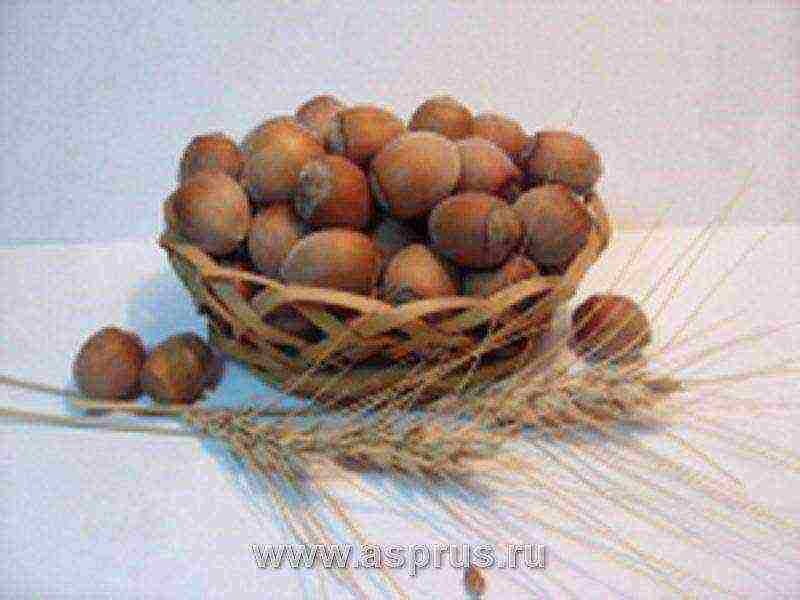
Badius
Badius. Seedling from free pollination of the hazelnut population of the Ustimosky arboretum. Received at the Ukrainian Research Institute of Forestry and Agroforestry and M.N. Vysotsky. Medium ripening. Universal purpose. Shrub 3.6 m high with a rounded crown of medium density. Fruits are of medium size, truncated - oval in shape. The kernel output is 48.3%. The fat content is 66.3%, the protein content is 16.5%. Accepted for state variety testing in 1982. Recommended for testing in the North Caucasus region.

Barcelona
Barcelona The bush is vigorous, branched, spreading at the top, with wrinkled, slightly shiny large leaves. Fruits 1 - 4 together. The envelope is fleshy, whole, slightly exceeding the length of the nut, open, with dense pubescence. The nut is round, large, full-bodied, lumpy, flattened in the upper part from wide sides, 2.5 cm long, 2 cm wide and 1.7 cm thick. The base of the nut is large, slightly convex. The shell is dark brown, thick and hard. Kernel 42.69%, fat content 68.14%. The variety is resistant to pests. Deserves a production test in the Transcaucasia and the North Caucasus. In the USA, it is the most popular and accounts for 85% of the gross harvest of hazelnuts.
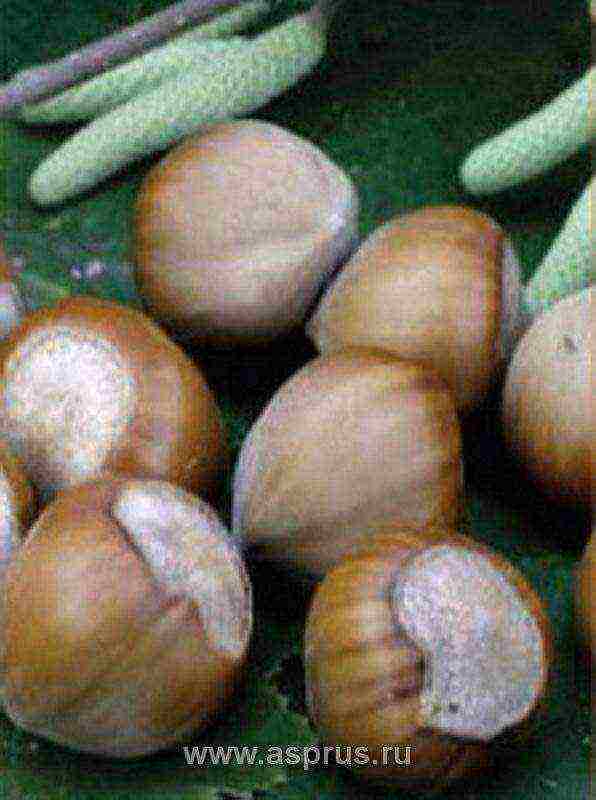
Barcelona
Barcelona European grade. The bush is vigorous, forms a branched, dense crown. Resistant to low temperatures. In our (Ukraine) climate it grows up to 5 m in height. The leaves are large or very large (length up to 14 cm, width up to 12 cm), elliptical or rounded, light green, the upper side is darker, the lower one is lighter, there are villi on the veins. The edges of the leaves are finely serrated, the apex is strongly serrated. Earrings are numerous, rather large (length up to 9 cm, diameter about 7 mm), usually 2 - 3 in a bunch, light green in color. The flowering time is medium - early.The podovaya shell is very large, almost 2 times as long as the nut, wide, unfolded, with long denticles along the edges. During the ripening period, the shells open and the nuts fall freely. Nuts are large, of various shapes, often ovoid or conical, slightly flattened, irregularly grooved or angular, often triangular. The size of the nut is 25x20x17 mm. The shell is rather thick, red-brown, shiny below with dark brown stripes, lighter at the top, pubescent. The top of the nut ear is often pointed. The kernel is large, asymmetrical, flattened, juicy, sweet. Covered with a wrinkled, fine-fibered, thin, brown shell. Sometimes there are small voids inside the core. Nuts ripen in the first half of September. The variety is marketable, very productive, early fruiting. The disadvantage of the variety is its instability to moniliosis. Pollinators: Halle, Miracle of Bolwiller, White Lambert, Daviana.
Barcelona angular Medium-sized walnut, thick-brown. The passage through a 13.2 mm sieve (small nuts) is 2.0 - 2.4%. The yield of the core from the rest on the sieve is 41.6%, which corresponds to the specification. The total kernel yield is 42.4%. The elongated shape of the walnut does not correspond to the specification, since it makes it difficult to process it on the equipment of the enterprise (the walnut, together with the kernel, is split in half). After dehulling, the yield of the kernel from a batch of such nuts will be very low (a lot of scrap). The quality of the kernels is very good: all rejection indicators are absent, the mass fraction of moisture in the kernels is optimal - 4.40%.
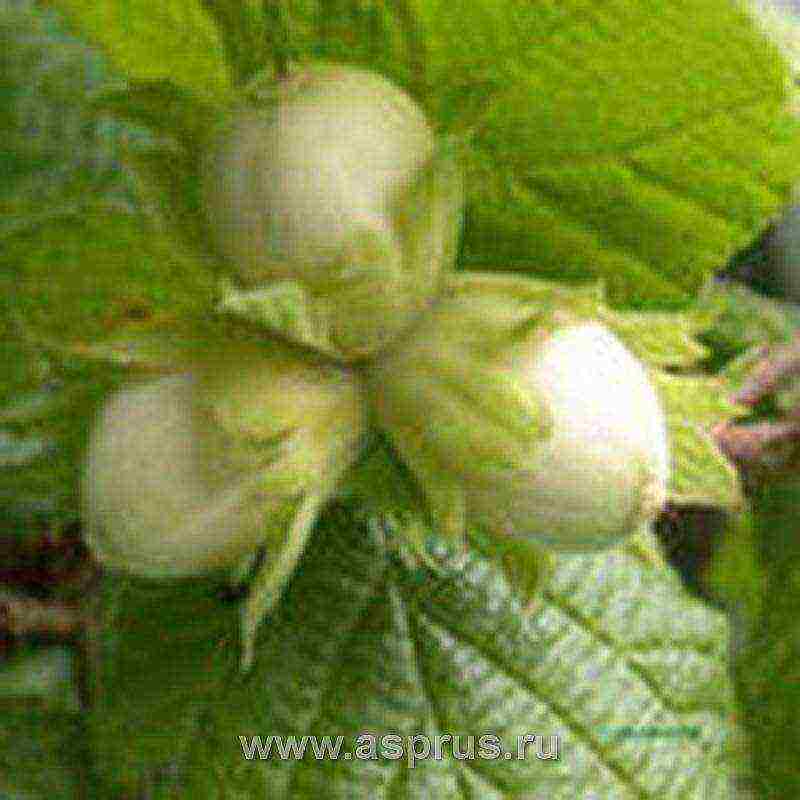
Berdznula
Berdznula this variety of walnut is found throughout Western Georgia, but it is most widespread in Guria and Samegrelo. High-yielding, fast-growing variety of Georgian selection. Berdznula belongs to high-yielding, fast-growing varieties. The first harvest gives three years after planting, but reaches its maximum at the age of 7 - 15 years. The height of the bush is 4.5 m, diameter is 4.7 m. It blooms in February - early April. The first to bloom are female flowers. The harvest ripens in late July and early August. One bush produces an average of 5 - 10 kg. The fruit is more than medium in size with a beautiful light brown color, which tightly fills the shell. The husk is slightly larger than the fruit. Reaching ripeness, the husk easily comes off the nut. Weight ranges from 2.1 - 2.5 grams. The shell thickness reaches 1.3 m. The kernel yield is 49 - 53%, the fat content is 63 - 67%, the average yield is 26.5 c / ha, the maximum yield is 37.7 c / ha. Frost resistance - 32 ° С.
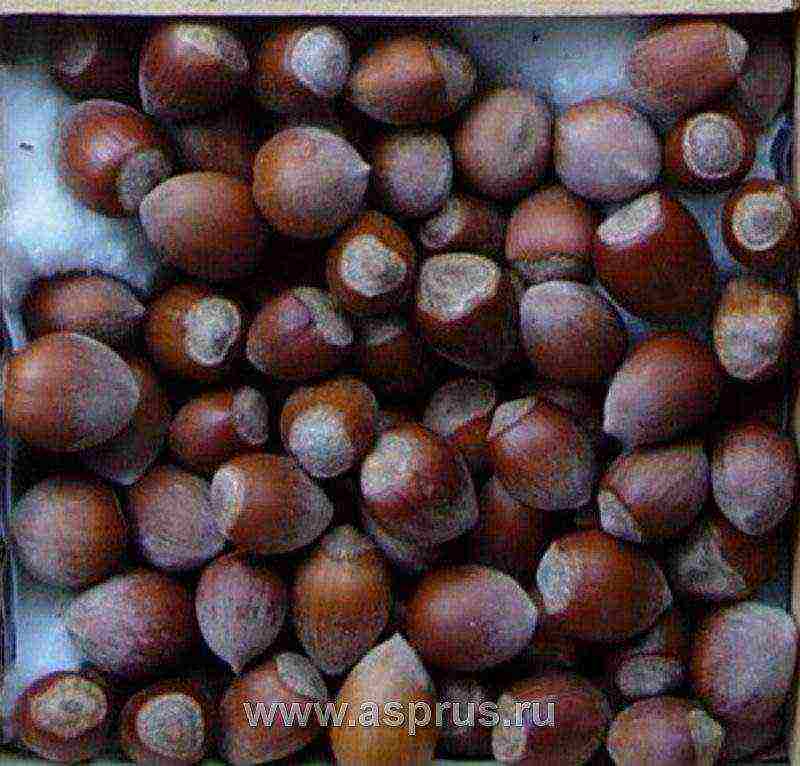
Bolgrad novelty
Bolgrad novelty A seedling from free pollination of a Western European variety. Received at the Ukrainian Research Institute of Forestry and Agroforestry and M.N. Vysotsky. Zoned since 1981 in the Steppe zone. Medium ripening. Highly winter-resistant selection. The average yield is 13 c / ha, the maximum - 23.8 c / ha. Needs protection against weevil weevil. A medium-sized bush with a spreading crown and shoots extending at right angles. Fruits are one-dimensional, medium-sized (1.4 g), round, slightly ribbed, with a slight sharpening towards the apex. The shell is of medium thickness, hard, brown, slightly striped. The kernel is dense, creamy at the break. The kernel yield is 46.2%, the fat content is 64.5%, and the protein content is 20.3%. Tasting score 4.8 points. A promising variety. Recommended for testing in the North Caucasus region. Pluses: Highly winter-resistant. Disadvantages: Needs protection against walnut weevil.

Bomb
Bomb (Kakhsky 35) Azerbaijani variety of national selection. The bush is of medium vigor, rounded, height - 3.8 m, diameter - 4.8 m. It blooms in February - early April. The first to bloom are female flowers. Nuts ripen in early September. Fruits are collected in multiples of 2 - 4 pcs. Nuts are flat-round with an even or slightly convex base, 18x22 mm in diameter. The shell is light brown with a striped pubescent bloom, 1.2 mm thick. Kernel 49%, tasty, fat content 67.18% .. Kernel yield - 41.8%, fat content - 67.1%.The average yield is 16.9 c / ha, the maximum - 39.6 c / ha, 9.4 kg per bush. Frost resistance - 32 ° С.

Borovsk
Borovsk Variety of selection of the UkrNII of forestry and agroforestry them. G.M. Vysotsky. The author is F.A.Pavlenko. The variety is of medium ripening (in the zone of the northern forest-steppe of Ukraine, nuts ripen in the third decade of August). Advantages of the variety: high winter hardiness and productivity, relative unpretentiousness to growing conditions. The bush is vigorous (up to 4.5 m), not prone to thickening. Growth capacity is low. It lends itself well to standard shaping. Harvest in the 7th year after planting reaches 20 kg / ha. In fruit stems - from 2 to 6 nuts. The envelope is slightly longer than the nut, pubescent, with a scalloped edge. Nuts are elongated - conical, flattened on the sides, with an even base, medium size, 2 cm long, weighing 1.9 - 2 g. Shell is light brown, medium pubescent, thin. Kernel yield - 48- 51%, the kernel is elongated, creamy, good taste. The oil content in the core is 70%, proteins - 16%. Root-forming ability during propagation of the variety by layering and green cuttings is low. Recommended pollinators: forest hazel, varieties Dolinsky, Stepnoy, Dar Pavlenko. The variety has been included in the State Register of Plant Varieties of Ukraine since 1991. It is of interest to amateur gardeners, farmers, beekeepers in the forest-steppe and steppe zones of Ukraine.
Bratolyubovsky Received at the Ukrainian Research Institute of Forestry and Agroforestry named after V.I. G.N. Vysotsky. Accepted for state variety testing in 1984. Recommended for testing in the North Caucasus region.
Bykhtinsky Received at the All-Russian Research Institute of Floriculture and Subtropical Crops. Accepted for state variety testing in 1979. Recommended for testing in the North Caucasus region. Buttner is a Western European cultivar. Nuts are large, 2.1 cm long, 2.0 cm wide and 1.8 cm thick, rounded, sometimes unequal, with a large convex or tuberous base. There are no small nuts. The shell is thick, brown in color, covered with soft gray pubescence. Kernel 39.2 - 41.8%, tasty, fat content 65.6%. The quality of the kernels is good. Nuts ripen in the second half of September. Harvest 5-7 kg per bush. The shape of the nut allows you to process (crush) it on equipment without significant losses. Of the rejection indicators, only dried kernels are present in the amount of 1.3%, which, according to the specification for hazelnut kernels, corresponds to the 2nd grade and is subject to acceptance.
Vartashensky 2/39 A variety of Azerbaijani origin, is a derivative of the Ata - Baba variety. A medium-sized bush with a densely leafy spherical crown. Forms a lot of growth. The advantages of the variety are a relatively high, stable yield, high kernel yield, high marketability and taste of the fruit. The average yield from one bush at the age of 17 is 6 - 7 kg of nuts (20 - 23 kg / ha). The disadvantages of the variety are low winter hardiness, weak resistance to bacteriosis. Blooms in February - March. Fruits 6-7 years after planting. Nuts ripen late - in the first decade of September. Forms 4 - 5 or more fruits in seedlings. Nuts of medium size (2 g), with a thin shell (0.8 mm), with a good kernel yield (up to 50.6 - 52.3%) and a fat content (up to 68.5%). Recommended for extensive production testing in all hazelnut growing areas.
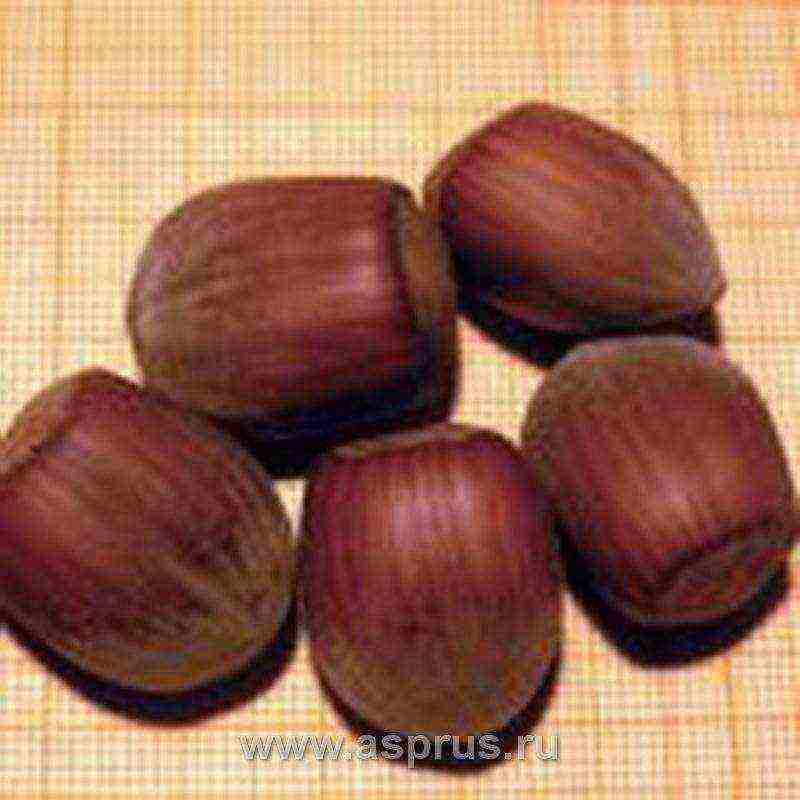
Warsaw red
Warsaw red (Varshavsky chervoniy) European grade. A vigorous bullet-shaped bush. Nuts are large, elongated, very tasty, ripens in the second half of September. A very decorative variety with red leaves, the leaves of the bush gradually turn green in summer and turn red in autumn. Pollinator: Halle. Pollinator: Halle. The yield of the core is 48 - 51%, with the content of fat in the core 69 - 73%, protein 14%, sugars 8%. The kernel is in a light thin film, delicate, sweetish, in normal room conditions it remains in good condition, almost without losing its taste, for 3-4 years. The flowering time of male earrings and female inflorescences is the same. The stigmas are bright crimson in color.
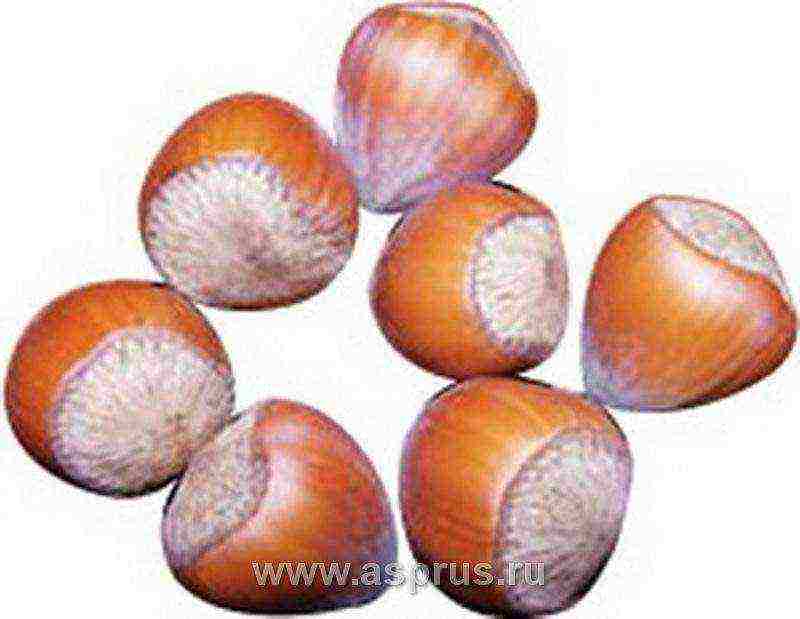
Halle
Halle (Galsky) German variety, bred in 1788, a vigorous bush, forms a large, branchy, medium-dense crown. Grows up to 5.5 m in height.The placement of leaves is quite dense, the leaves are large or medium (length up to 12 cm, width up to 9 cm), elliptical or round, often with several cuts and a small pointed apex, dark green, with rough villi. Develops numerous male inflorescences, in clusters up to 6 pcs., Up to 7 cm long, about 5 mm in diameter, grayish brown with a purple bloom, pubescent. The flowering time is medium early, usually blooms at the same time with many other varieties. The fruit coat is the same length as the nut, sometimes longer or shorter, rough, fleshy, with villi at the base. The edge of the leaves with uneven teeth, the leaves are adjacent to the nut. During the ripening period, the shell turns yellow and opens, the fruits fall out quite easily. Nuts of attractive appearance, large and very large, conical, strongly tapering towards the top. Walnut size 28x25x23 mm. The shape is usually correct, slightly flattened. The shell is thick, yellow-brown or brown with dark stripes, smooth, shiny, with a light bloom at the top. The kernel is large, ovoid, with a sharp tip, covered with an easily detachable dark brown, coarse fibrous membrane, light creamy, sweet, tasty. Nuts ripen late, usually in the second half of September - early October. There is no need to rush to harvest, as prematurely harvested fruits lose weight, and their taste also deteriorates. One of the most productive varieties, it bears fruit abundantly and regularly. The variety needs fertile soil, does not germinate in cold and waterlogged soil. This variety also requires good pollinators, such as Barcelona, Cosford.
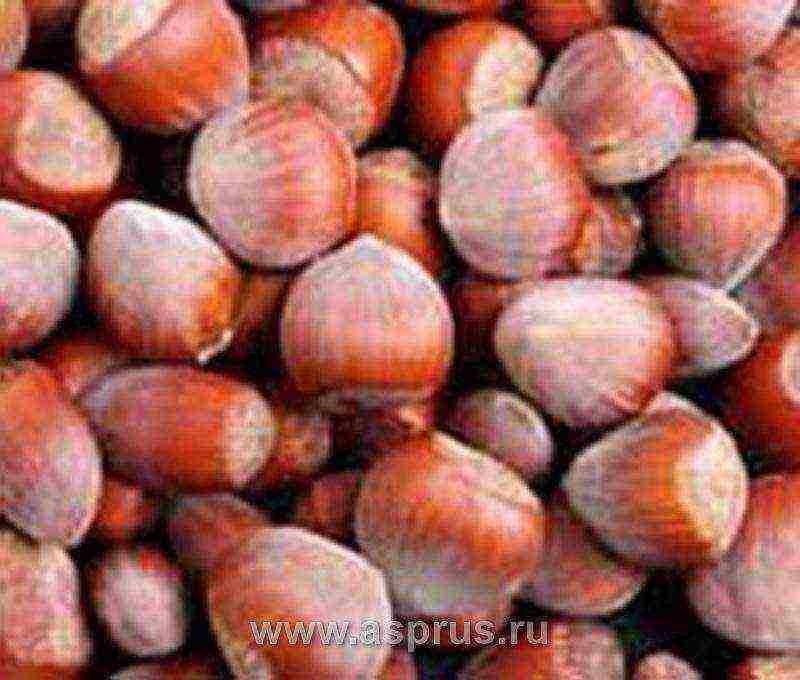
Gaulish Zellian
Gaulish Zellian The variety was bred in 1788 by Buttner in Germany (Halle). Leaves are of medium size, ovoid, rounded, with a cordate base, along the edge with lobe-like teeth and a short cusp. Plots of 2 - 3, rarely one at a time. Envelope equal to or slightly longer than nut, dissected into irregular dentate lobes with sparse glandular hairs. Nuts are ovoid-conical, 2.2-2.5 cm long and 1.8-2.0 cm wide. The shell is brown, shiny, soft pubescent on top, 1.5 mm thick. The core of excellent taste, 42%, fat content 63.94%. Collecting nuts in August - September. Weight of 1000 nuts 3 - 3.4 kg. Harvest 5 - 7 kg per bush.
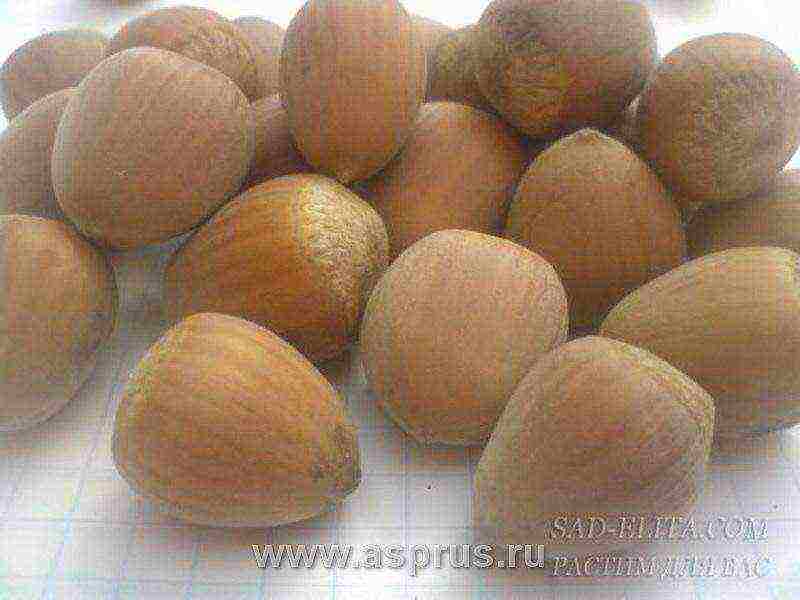
Ganja
Ganja - hazelnuts (CTN - 69). Bushes vigorous, 10 - 12 m in height. Fruits in bunches of 3 - 4 together, with an open wrapper, 1.5 times its length. Walnut 16x19x18 mm. The shell is thin, 0.8 - 1.0 mm thick. Kernel 57.5%, fat content 69.4%. Harvest 15 - 18 kg of pure nuts per bush. The variety is distinguished by the Zakatala reference point, has very high merits, and in terms of kernel yield, along with the well-known Evgenia variety, it occupies the first place among all still known varieties and certainly deserves widespread introduction into industrial hazelnut orchards.
Hybrid 19 Ukrainian varieties of F.A. P avlenko. Comes from the crossing of a hazelnut with a bear nut. At the age of 17, it has a height of 5.9 m and a diameter of 6.3 m. The growth pattern is intermediate between a tree and a bush. Rounded to oval. On the upper side, green or dark green, evenly slightly pubescent, on the lower side, light green with a bluish tinge and more intense pubescence along the nerves. The base is deeply heart-shaped, the apex is pointed up to 1.5 cm in length. The edges are broadly toothed, with emerging lobes. Leaves are 7-15 cm long and 5-13 cm wide. Petioles are green, medium pubescent, up to 3 cm long. Fruiting from the age of 11. Fruits in bunches of 2 - 7. The envelope is 2 times larger than the nut, at the base is thick, fleshy, sticky, with coarse bristly-glandular pubescence. The upper part of the envelope is thin-skinned, divided almost to the middle of the length into pointed, branched, sparsely toothed lobes along the edges. When the fruit ripens, the wrapper usually cracks on one side, the lobes turn outward, exposing the upper part of the fruit.Nuts are broadly ovate, sharp-ribbed, flat-packed, light brownish yellow, with small whitish specks and pubescence in the upper part, 1.8 cm in height, 1.7 cm in width and 1.3 cm in thickness. The base is convex, large, often uneven. The shell is thin. The kernel is hard, fills the shell well, tasty, fat content 61.75%. Harvest - 6 kg per bush. Nuts ripen in the first half of September. Hybrid 19 is frost-hardy, drought-resistant and slightly damaged by pests and diseases. Recommended for industrial cultivation, erosion control planting and landscaping.
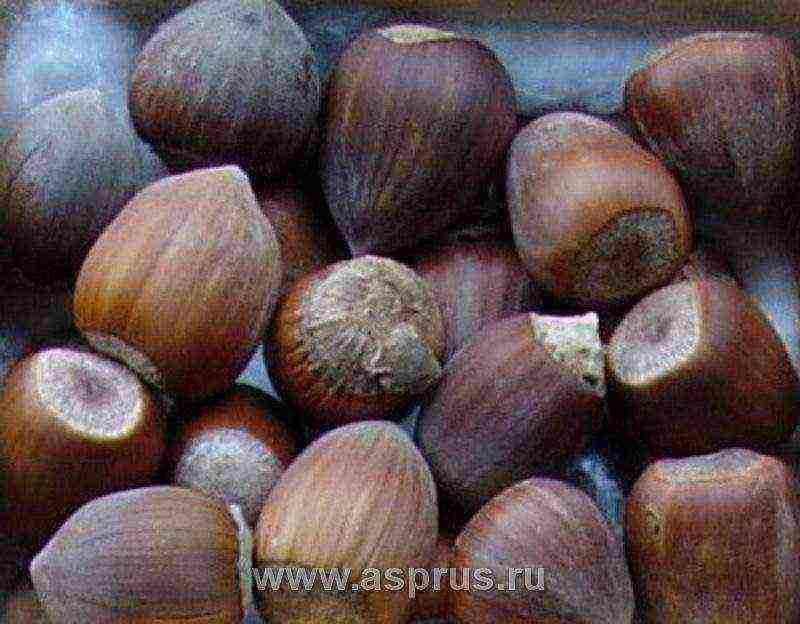
Hybrid 39
Hybrid 39 Ukrainian varieties of selection F.A.Pavlenko. Comes from pollination of a bear nut with a mixture of hazelnut pollen. At the age of 17, it reaches a height of 5.2 m and a diameter of 6 m. The growth pattern is also intermediate between tree and bush. The crown is broadly oval and consists of 8 rather thick stems, having a diameter of 4 to 7 cm at a height of 130 cm. The bark is light gray, with lenticels. On annual shoots, it is yellow-gray and with strong pubescence at the place of attachment to a two-year growth. Leaves are rounded, broadly oval with a deep heart-shaped base, ending in a narrow, up to 1.5 cm long, tip. The leaf blade is uneven, with outlined lobes. Leaves are 7–12 cm long and 5–11 cm wide. Leaf petioles are 1–3 cm long, more intensively pubescent in young leaves. Fruits of 2 - 5. The envelope at the base is thick, fleshy, tightly fused, twice the length of the nut, deeply divided into narrow lobes, which in turn are sparsely toothed and tied above the fruit. Nuts are naked, only pubescent in the upper part, similar in shape to the nuts of hybrid 19. Fruit 17x15 × 12 mm. The shell is thin. I draw 50.4%, fat content 65.29%. Possesses high winter hardiness and drought resistance. At the time of fruiting, they begin in the 10th year. Yield 11 kg per bush. Nuts ripen in the first half of September. Recommended for the creation of industrial plantations of hazel, anti-erosion plantings and for landscaping.
Hybrid No. 1 TLCA winter-hardy, green-leaved, undersized, good pollinator for red-leaved forms. For the central region (Moscow and Vladimir regions)
Hybrid No. 468 Red-leaved, large-fruited. The crown is very decorative - from raspberry-pink in spring, to raspberry-purple at the end of summer.
Hybrid No. 490 Red-leaved, early maturing and very productive. Fruiting almost annually.
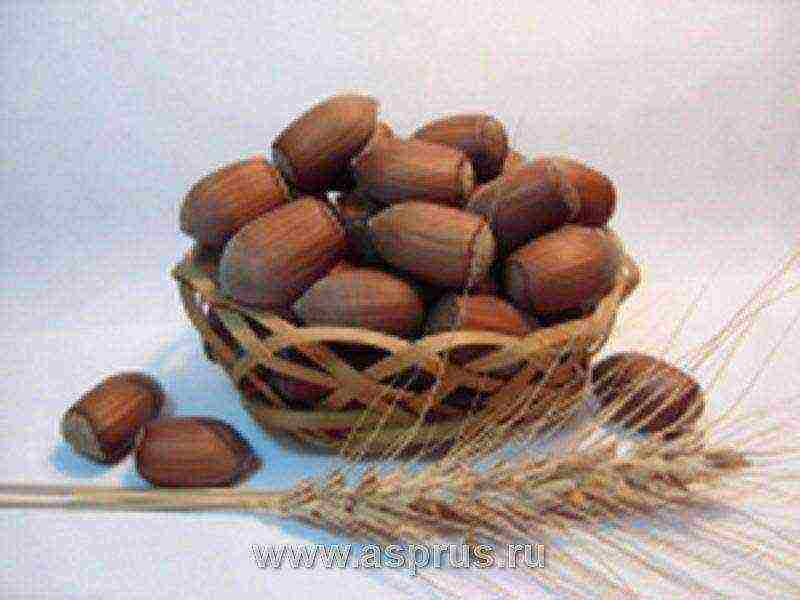
Grandiose
Grandiose Seedling from free pollination of the local form of the Sochi population. Received at the Ukrainian Research Institute of Forestry and Agroforestry named after V.I. G.N. Vysotsky. Medium ripening. Universal purpose. Shrub 5 m high with a rounded, sparse crown. Fruits with an average weight of 2.2 g, oblong - cylindrical, without ribs. The kernel output is 48.9%. The fat content is 66.7%. Tasting score 4.3 points. Accepted for state variety testing in 1983. Recommended for testing in the North Caucasus region.
Gubensky Western European cultivar. The bush is vigorous. Nuts are large, 23x20x16 mm, broadly ovate, slightly flattened, with a large convex or tuberous base. Weight 1000 nuts 2740 g. The shell is strong, light. The kernel fills the shell well. It is covered with a velvety brown sheath. Begins to bear fruit in the 4th year after planting. Harvest 8 - 9 kg of nuts per bush. The best pollinator is Cadetten (47.8%), self-pollination 2-13% and free cross-pollination 32.6% (Gusev, 1964).
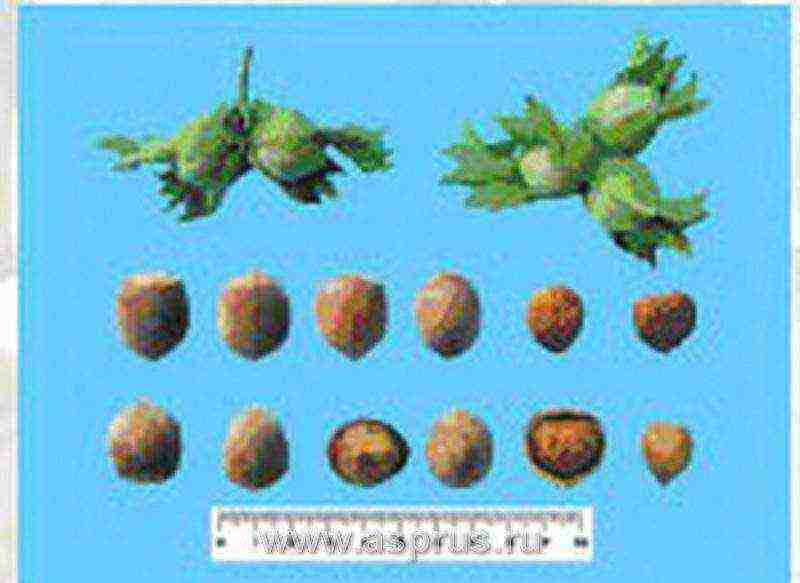
Gulshishvela
Gulshishvela This variety is one of the best in Georgia in terms of its taste and organoleptic data. Gulshishvela is widespread in both Western and Eastern Georgia, but he is more accustomed to humid subtropical regions. In Guri and in the Ozurgeti region, different varieties of walnut are widespread, but the occupied area of Gulshishvela takes the first place. This nut variety is fast-growing, the bush is round and branched, begins to multiply three years after planting, the harvest is generous - one bush produces an average of 4.5 - 5 kg.This variety is an early breed, the harvest can be harvested from late July to early August. The husk of the fruit is shorter than the nut, on one side it is cut almost to the end, from which most of the fruit does not close, therefore this nut is called "Gulshishvela". A pod of medium size, measuring 20 x 19 x 18 mm. The shell is dark brown, of medium thickness - 2.0 mm. The weight of one nut is 2.1 gr. The fruit fills the shell well. The yield of the kernel overestimates the climatic factors and ranges between 48 - 52%. Fat content of the fruit is 63 - 67%.
Gustav Western European cultivar. The bush is vigorous. Nuts 2 - 4 together, and sometimes one at a time, large, elongated, 27x20x19 mm, cylindrical, oval-ovoid, slightly flattened laterally at the base. There are no small nuts. Weight 1000 nuts 3220 g. The shell is thick, strong. Kernel yield - 42.0 - 49.4%, which corresponds to the specification, fat content 66.12%. The elongated shape of the nut, as well as the poor separation of the kernel from the shell, does not allow processing it on equipment (the nut together with the kernel will split in half and crumble). After dehulling, the yield of the kernel from a batch of such nuts will be very low (a lot of scrap). The quality of the kernels is average. Among the rejection indicators, there are dried kernels - 2.0% and kernels with surface damage - 0.2%, the mass fraction of moisture in the kernels is optimal - 4.46%. The best pollinators: Nottingham - 37% and Eugenia - 24.5% of the ovary. With self-pollination, 1% of the ovary is obtained. Productivity 6.2 - 10.4 kg of nuts per bush.
Davydovsky A seedling from free pollination of an unknown form, selected in a nursery. Received at the Ukrainian Research Institute of Forestry and Agroforestry named after V.I. G.N. Vysotsky. Medium ripening. Universal purpose. Shrub 3.8 m high with a crown of medium density. Pods with an average weight of 1.8 g, rounded, without ribs. The kernel output is 48.5%. Fat content 6 4.6%, protein 16.3%. The core of a pleasant sweetish taste. Accepted for state variety testing in 1980. Recommended for testing in the North Caucasus region. Advantages: The core of a pleasant sweetish taste.
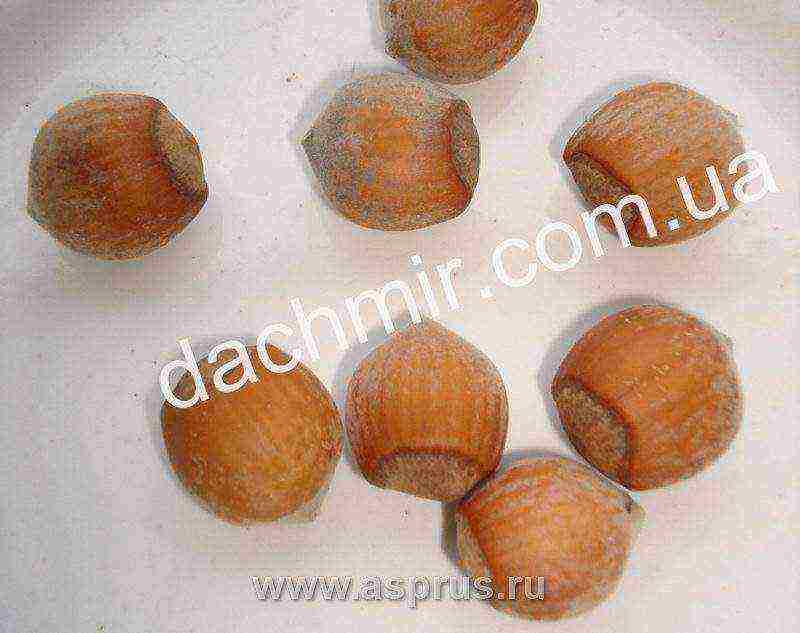
Gift of Pavlenko
Gift of Pavlenko Seedling from free pollination of the form of the Sochi population. Received at the Ukrainian Research Institute of Forestry and Agroforestry named after V.I. G.N. Vysotsky. Medium ripening. Universal purpose. Bush 4.3 m high with a rounded crown of medium density. The fruits are large (2.5 g), oblong, without ribs. The kernel output is 48.8%. Fat content 66%, protein 18.4%. Accepted for state variety testing in 1983. Recommended for testing in the North Caucasus region. Pluses: Large fruits.
Dedoplistita Other names - Bademi, Lady's finger, hazelnut Akaki Tsereteli... The local Georgian variety is considered to be the homeland of this nut, ancient Colchis, from where it spread to Abkhazia, Eastern Georgia, Crimea and the regions of Adler. In the Ozurgeti region it is called “Akaki” nut. Early (In Western Georgia ripens from July 15 to 20, and in eastern Georgia 5 to 10 August) ripening period. Productivity 10 - 19 kg / ha (on average 4.8 kg per tree). Differs in high demands on moisture. It is characterized by good separability of the plyus from the pericarp, which allows the use of a mechanized harvesting method. Universal purpose. Fats derived from fruits are used in medicine as a substitute for almond oil. Medium and evenly growing medium-sized shrub with upright and slightly branched crown and with a slight ability to form root shoots. The fruits are large, beautiful, one-dimensional, oblong-flattened, with a characteristic groove running from the base to the top. The base is rounded, slightly elongated, light gray in color. The wrapper is 1.5 times longer than the fruit and has the shape of a heart, whole, tubular, closely adjacent to the fruit, light green, slightly pubescent. The fruit has the shape of a cylinder and is larger than the average size of 25x17x15 mm. The shell is thin (0.5 - 0.8 mm). The kernel is covered with a pinkish-yellow skin and has a high taste.Kernel yield 48.8 - 52 - 53%, taste like almonds, fat content - 67.5 - 68%, sugars - 6.8%. One bush gives an average of 4 - 4.5 kg of yield. Tasting score 4.4 points. State test since 1969. Included in the state register in 1995 for the North Caucasus region. Advantages: Mechanized harvesting is possible. Fats derived from fruits are used in medicine as a substitute for almond oil. Disadvantages: Demanding on moisture.
Long Landsberg Western European cultivar. Spreading bush, gives a lot of growth. Walnut and 3.0 cm in height, 1.8 cm in width and 1.7 cm in thickness, cylindrical, sometimes slightly ribbed, with m soft pubescence in the upper part. Weight of 1000 nuts 3.86 kg. Kernel 45.11%, fat content 64%. Productivity 7 - 8 kg per bush.
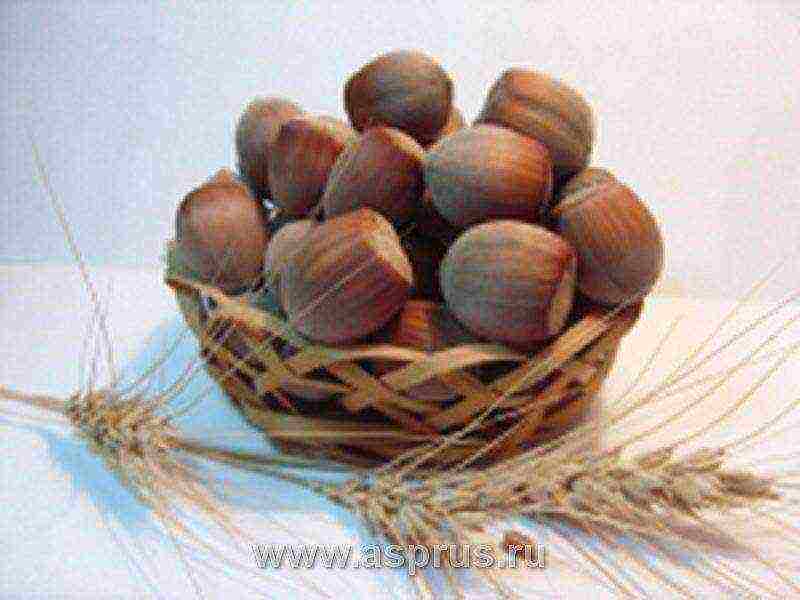
Dolinsky
Dolinsky An early ripe variety of hazelnuts, selected by the Ukrainian Research Institute of Forestry and Forest Melioration. G.M. Vysotsky. Obtained from seedlings grown from a mixture of seed varieties in hazelnuts of North Caucasian origin. Breeder F.A. Pavlenko. Differs in early maturity, fairly high, stable yield, winter hardiness of the plant as a whole and catkins, unpretentiousness to growing conditions. An excellent pollinator for most varieties. Root-forming ability during propagation by layering and green cuttings is high. The bush is vigorous. Growth capacity is average. It works well in the standard culture. Forms a large number of very early dusting earrings. Fruits are collected in seedlings of 2 - 6 pieces, in loose wrappers one and a half times longer than a nut. Nuts are of medium size (1.9 g), slightly elongated, widened towards the top. The shell is brown, medium pubescent at the base, thin. The kernel is round, well cleaned from the film when ignited, creamy, excellent taste. The kernel output is 50%. The kernel contains 67% oils, 17% proteins. Removable and consumer maturity of nuts in the zone of the Northern Forest-Steppe of Ukraine begins at the end of the first - beginning of the second decade of August.
Profitable the average fruit weight is 3 g, the kernel content is 45.6%, the fat content is 67.9%, the average yield is 21.7 c / ha, the shell thickness is 1.3 mm (thick-bore), the average weight is 100 pcs. dry nuts - 193 g
friendship A seedling from free pollination of a Western European variety. Received at the Ukrainian Research Institute of Forestry and Agroforestry named after V.I. G.N. Vysotsky. Medium ripening. Universal purpose. Bush 5 m high with a slightly compressed crown of medium density. Fruits with an average weight of 2.2 g, oblong-cylindrical, slightly ribbed. The kernel yield is 50.7%, the fat content is 60%, the protein content is 16%. Tasting score 4.3 points. Accepted for state variety testing in 1983. Recommended for testing in the North Caucasus region.
Evgeniya Western European cultivar. The bush is vigorous, but compressed. Leaves are rounded, obovate, oblong, twice serrate-toothed along the edge, with a medullary base and a string-tip 1 cm long, pubescent below, 5-8 cm long and 4-7 cm wide. The petioles are short, 0.5-1 cm long, covered with simple and glandular hairs. Fruits of 2 - 4. Envelope whole, shorter than or equal to nut, deeply dissected into lanceolate sparsely toothed lobes, pubescent with simple hairs. Walnut 22-25х14х12 - 13 mm, light brown, with pubescence in the upper part. The shell is thin, fragile. The kernel is 57.5%, dense, tasty, fat content is 66.79%. Branded bushes of this variety are available at the Sochi Experimental Station of subtropical and southern fruit crops. In the conditions of Sochi, it blooms in February - March, harvested at the end of August (3.5 kg of nuts per bush). It is weakly affected by pests and diseases.
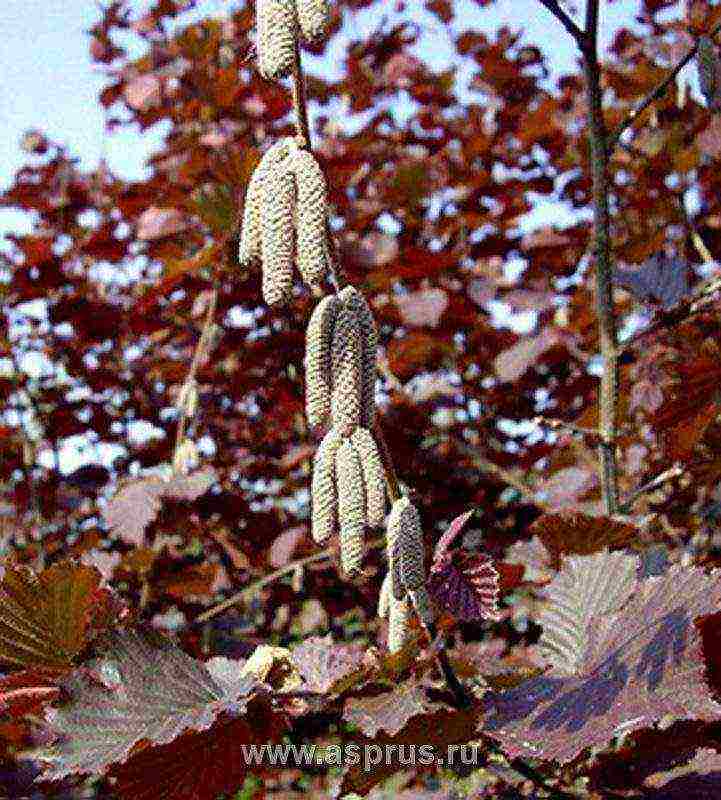
Ekaterina
Ekaterina (hybrid 12 - 34) (hazelnut variety) in 1961, from the crossing of the elite in the forests of the Steppe forestry of the Tambov region. forms of common hazel No. 454, with red-leaved hybrid hazelnuts No. 236 from the hybrid fund of A.S. Yablokova R.F. Kudasheva got this grade.The bush is vigorous, with a red color of the leaves, the wrapper and nuts are colored from pinkish to dark crimson. The nut wrapper is often dissected on one side of the nut, it is much smaller than the nut, and thin. The nut is long, very large 30x19x18 mm. Slightly wider towards the apex, the base is convex, even, smooth, the apex is not pointed, the shell is thin. Dessert variety. The kernel yield is 54%. This variety can grow in Central Russia and in the South. In the southern regions it ripens late.
Zorinsky Obtained by crossing the varieties Cherkesskiy 2 and Badem. Received at the All-Russian Research Institute of Floriculture and Subtropical Crops. Early ripening. Universal purpose. The bush is 2 m high with a crown of medium density. Fruits are of medium size, round, slightly ribbed. The kernel output is 51.5%. Fat content 68.5%. Accepted for state variety testing in 1980. Recommended for testing in the North Caucasus region.
Zyudovsky Seedling from free pollination of the form of the Sochi population. Received at the Ukrainian Research Institute of Forestry and Agroforestry named after V.I. G.N. Vysotsky. Medium ripening. Universal purpose. The bush is 4 m high with a rounded crown of medium density. Fruits with an average weight of 2.2 g, round, slightly ribbed. The kernel output is 48%. Fat content 63.3%, protein 14.6%. Accepted for state variety testing in 1984. Recommended for testing in the North Caucasus region.
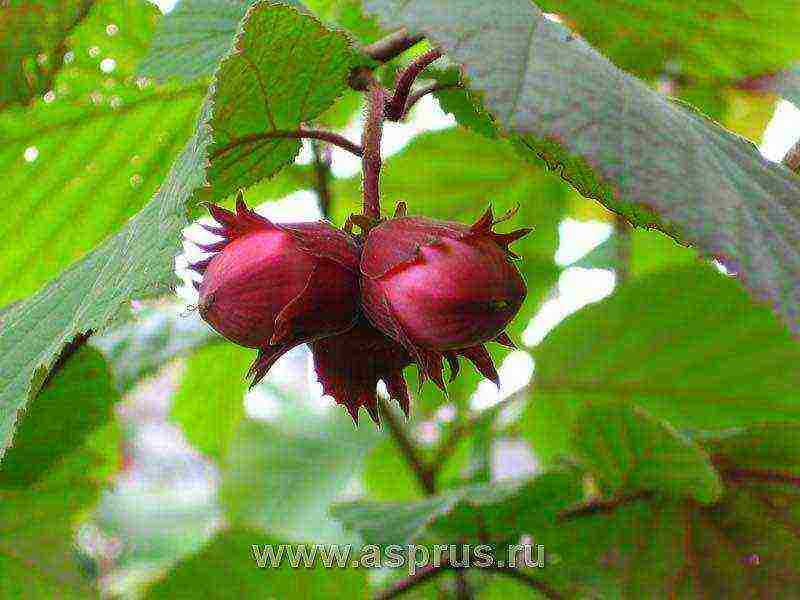
Ivanteevsky red
Ivanteevsky red Originator: Federal State Unitary Enterprise "Ivanteevsky Forest Selection Experimental - Demonstration Nursery". It was obtained by crossing the F-705 variety and the 468 hybrid (with the F-129 seed) at the NPO for walnut growing "Hazelnut" at the Serossiysk Scientific Research Institute of Forestry and Forestry Mechanization. Ivanteevsky red and Pushkin red are similar to each other, like relatives of brothers. Both have burgundy foliage, but Pushkinsky has a little darker. Medium ripening. Winter hardiness is high. The average yield is 4.4 c / ha, the maximum - 9.1 c / ha. It is a good pollinator for green-leaved forms. Universal purpose. The bush is 4.5 m high with a dense, narrow pyramidal bottom, from the middle of the bush - an expanded crown. The leaves are large, red in color (by autumn the leaves are dark green), back - ovoid. The fruit is medium, weighing 1.9 g, wide ribbed, oblong: 27x23x17 mm. The rind is medium, smooth, with thin stripes, brown, towards the top - light brown. Kernel yield 46%, fat content 64%. Average yield 4.4 c / ha. The maximum yield is 9.1 c / ha. Tasting score 4 points. State test since 1995. Included in the state register in 1996 for the Central, Central - Chernozem, North - Western, Middle Volga regions, recommended for the Central (Bryansk region, Kaluga region, Moscow region, Ryazan region, Tula region, Vladimir region, Smolensk region), Central - chernozem (Voronezh region, Kursk region, Lipetsk region, Oryol region, Tambov region), Northwestern (Leningrad region, Tver region, Pskov region, Novgorod region), Middle Volga (Penza region) regions. Pluses: High winter hardiness. It is a good pollinator for green-leaved hazelnuts.
(variety of hazel)
Isaevsky (variety of hazel) One of the most valuable varieties can also serve as an "amateur" variety - the Isaevsky hazelnut was named by RF Kudasheva in memory of the teacher and professor S.I. Isaev, obtained from crossing the Tambov hazel with the red-leaved variety Akademik Yablokov (Ivanteevsky nursery). The color of large fruits is light brown with dark brown stripes, they have an excellent taste. This hybrid is very frost-hardy, bore fruit abundantly even after the harsh and destructive winter of 1978/79 for apple plantations.
Caucasus A seedling from free pollination of an unknown form, selected in industrial plantings of the Krasnodar Tea Production Association. Received at the All-Russian Research Institute of Floriculture and Subtropical Crops in 1982.Medium ripening. The average yield is 21.8 c / ha, the maximum is 24 c / ha. It is characterized by good separability of the cupule, which makes it possible to mechanize the harvesting process. A high percentage of pollen viability (89%) allows us to recommend this variety as an effective pollinator in industrial plantings of hazelnuts. Universal purpose. Shrub 3 m high with a narrow pyramidal crown of medium density. Fruits are large (2.4 g), flattened-rounded, slightly ribbed. The kernel yield is 47.3%. The fat content is 67.5%, the protein content is 21%. Tasting score 4.5 points. Accepted for state variety testing in 1993. Included in the state register in 1999 for the North Caucasus region. Advantages: Adapted for mechanized harvesting. High percentage of pollen viability.
Cadetten Obtained in Germany, Western European cultivar. Vigorous, powerful, spreading bush with a wide crown. It is characterized by good yield. When ripe, the fruits crumble heavily. Universal purpose. Late ripening. Nuts in bundles of 3 - 4. The wrapper is short, up to 1/2 or 2/3 of the length of the nut, with large teeth. Nuts 25x18x16 mm, weighing 1.9 g, elongated - oval, elongated - conical or cylindrical. Weight 1000 nuts 2820 g. Shell is light brown, easily cracked. Kernel 42.89 - 50.8%, pure, good taste, fat content 65.73%, protein 12.5%. In the conditions of the North Caucasus, the variety is frost-hardy. It begins to bear fruit in the 4th year after planting. Productivity at 10 years of age is 14.3 kg per bush. The best pollinators are Louise (34.3%), Nottingham (28.5 - 51%), self-pollination 16%, and free cross-pollination 22 - 54%. Medium resistant to pests and diseases. Tasting score 4.1 points. Adopted for state variety testing in 1963. Included in the state register in 1986 for the North Caucasus region. Pluses: Highly winter-resistant variety. Good yield. Disadvantages: When ripe, the fruits crumble heavily.
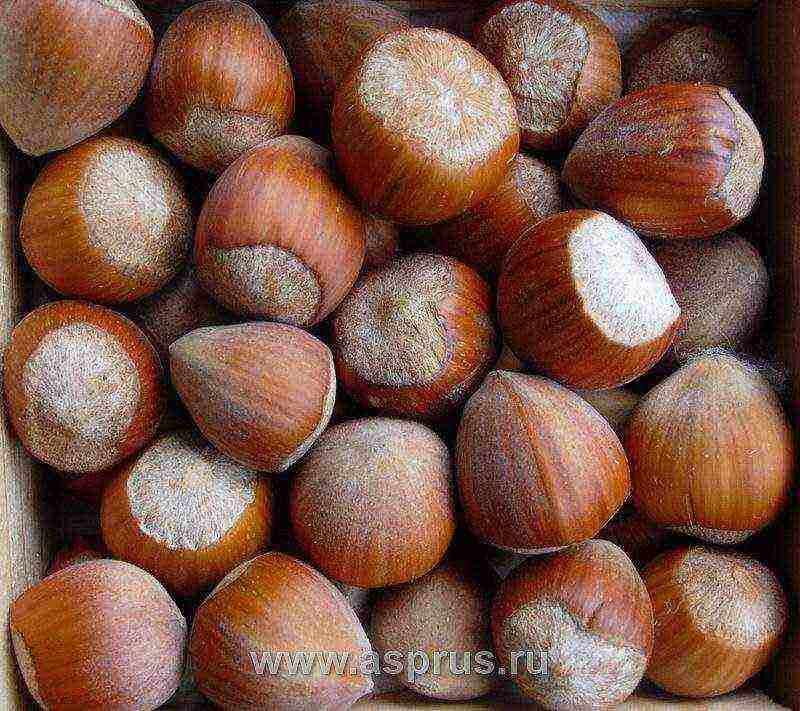
Karamanovsky
Karamanovsky (President) A clone of a local seedling sampled from private plantings. Originator: All-Russian Research Institute of Floriculture and Subtropical Crops. Medium ripening. The average yield is 25 c / ha, the maximum - 27 c / ha. Universal purpose. Shrub 3 m high with a drooping crown of medium density. The fruits are large (2.8 - 2.9 g), slightly elongated, smooth. The kernel output is 48%. Fat content 70%, protein 18%. The kernel is dense, of pleasant taste, the tasting score is 4.6 points. Accepted for state variety testing in 1992. Included in the state register for the North Caucasus region. Pluses: Large fruits. Pleasant taste.
The variety has been cultivated in Poland for a long time. The bush has a fairly strong growth but does not grow very tall. High quality nuts, large, round, collected in 3 - 5 pieces. The shell of the fruit is slightly shorter than the nut itself. During the ripening process, the shell opens, exposing most of the nut. Shells are of medium thickness, brittle, bronze in color. The nut tastes good, almost completely fills the shell. The variety has a good yield, flowering period in the mid-early period. Ripening of nuts occurs in the second half of September; after ripening, the nuts themselves fall out of the shell.
Received in England. Medium late ripening. Weakly resistant to pests and diseases. It is characterized by low productivity. Universal purpose. A vigorous, powerful bush. Fruits weighing 2.2 g, round - conical or elongated, smooth, bright brown. The kernel yield is 39.7%, the fat content is more than 70%. Tasting score 4.1 points. Accepted for state variety testing in 1968. Included in the state register in 1983 for the North Caucasus region. Disadvantages: Weakly resistant to pests and diseases. Low yield.
Kerasund long (Sivri kerasund) Spreading bush, reaching 5 - 6 m in height and 6 m in diameter.Leaves are rounded or broadly oval with a sharp tip, twice serrate-toothed - pubescent on the lower and upper sides along the veins, 10 cm long and 9 cm wide. Fruits 1 - 4, sometimes up to 6. Envelope whole, tubular, pubescent with simple and glandular hairs, 2 times the size of a nut, with an interception in the middle and widening towards the end, cracks when ripe. Nuts are ovoid - conical, flattened, tapering towards the apex, with a large, vaulted light gray base, 2 cm long, 1.6 cm wide, 1.6 cm thick. The shell is thin, fragile, golden brown with longitudinal darker stripes. Weight of 1000 nuts 1940. Kernel 50%, excellent taste, fat content 67.79%. The variety is fruitful, demanding on moisture and soil. Nuts ripen in early August. Harvest 6 kg of nuts per bush. Included in the industrial range of the Caucasus.
Kerasund round (Yagly - hazelnuts) The bush is sprawling, almost spherical, reaching 5 m in height and the same diameter. Leaves are rounded or broadly oval, twice serrate-toothed, 8 - 12 cm long, 7 - 10 cm wide. Fruits are 2 - 4. Envelope densely pubescent, its length is 2 - 2.5 times the nut, whole, tubular with an interception in the middle. widening towards the apex, along the edge with small serrated lobes. Nuts are round, pointed, sometimes ribbed, irregular, 17-20x16-18x15-17 mm. The base of the nut is flat or lumpy. The shell is thin, golden brown, pubescent in the upper part. The kernel (53.63%) is oily, sweetish, fat content 71.86%. Nuts ripen in early August, the yield per bush is 8 kg. Gives abundant growth. It is resistant to drought and pests, and is thermophilic. The variety ranks first among the industrial varieties of the Caucasus in terms of oil content and kernel yield and deserves widespread introduction into the hazelnut orchards being created.
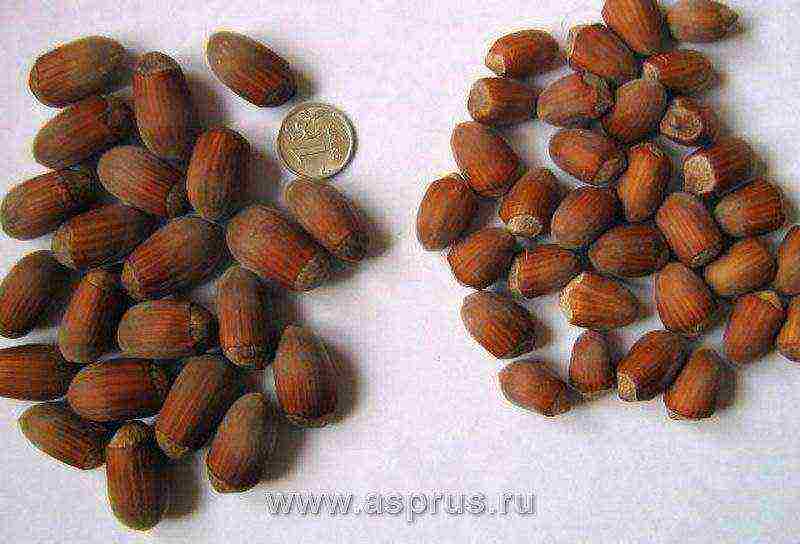
Kirovograd
Kirovograd Seedling from free pollination of the Badem variety. Received at the Ukrainian Research Institute of Forestry and Agroforestry named after V.I. G.N. Vysotsky. Medium ripening. Winter-hardy, fruitful. Universal purpose. The bush is 5 m high with a rounded crown of medium density. Shoots of medium length, geniculate, olive-yellow, pubescent. Fruits are of medium size, oblong, flattened, slightly ribbed, with a pointed apex. The pluck is twice as long as the nut. The kernel output is 47.8%. Fat content 67.1%, protein 16.8%. A promising variety. Recommended for testing in the North Caucasus region. Pluses: Winter-hardy, fruitful.
Wedge-shaped zoned since 1988 in the Forest-steppe. Medium ripening. The wrapper is slightly longer than the nut and is dissected into serrated lobes. Nuts are ellipsoid-wedge-shaped, 2 cm long, with a slightly convex base, brown and light brown, with darker oblong stripes, slightly ribbed, weighing 1.6-2.3 g. Kernel yield 50%.
Kontorta (Common hazel) - it is a shrub up to 5 m tall, with a grayish bark, pubescent young shoots, almost rounded leaves, up to 12 cm long, slightly lobed, dark green, glabrous, dull, light green below, pubescent along the veins. It blooms in early spring, before the leaves open, and is distinguished by the special grace of its numerous dangling earrings. The fruit is a round or oblong nut. The most exotic type of hazel with twisted, strongly twisted shoots and wrinkled leaves. In spring, its bare, twisting branches with dangling earrings look fantastic. The variety grows slowly. Up to 3 meters high. Planting is done for better plant survival in spring or early summer. An openwork construction of curved and twisted branches. This variety is recommended to be pruned, leaving only a few of the most “spectacular” branches. Looks best single planted in a conspicuous place.
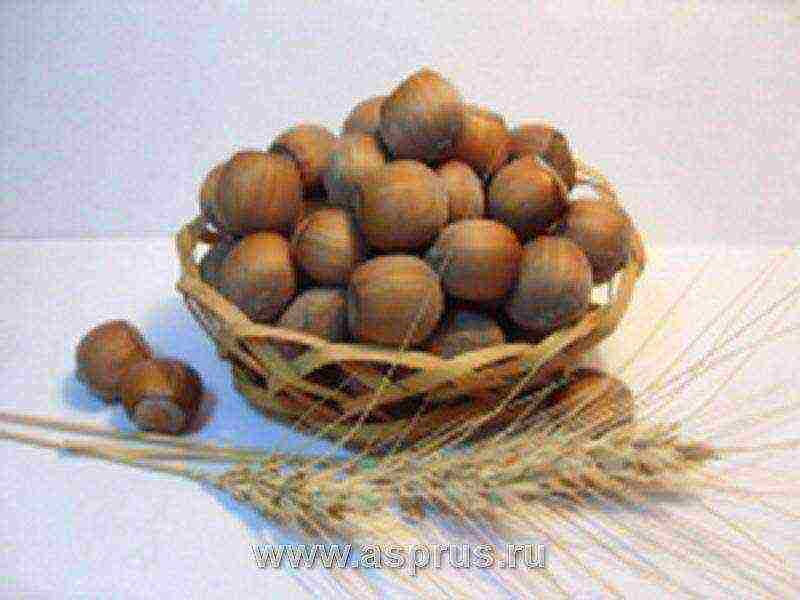
Crowned
Crowned (Excellent) Seedling from free pollination of the form of the Sochi population. Received at the Ukrainian Research Institute of Forestry and Agroforestry and M. N. Vysotsky. Zoned since 1991 in Polesie.Middle (first decade of September) ripening period. Universal purpose. The bush is up to 5 m high. Shoots are of medium length, straight, greenish-brown, pubescent. Fruits with an average weight of 1.7 - 2.2 g, rounded, slightly ribbed, the plyusa is almost equal to the length of the nut. The kernel output is 47.2%. The fat content is 66.8%, the protein content is 16.4%. The kernel is sweetish with an oily aftertaste. A promising variety. Recommended for testing in the North Caucasus region. Advantages: The kernel is sweetish with an oily aftertaste.
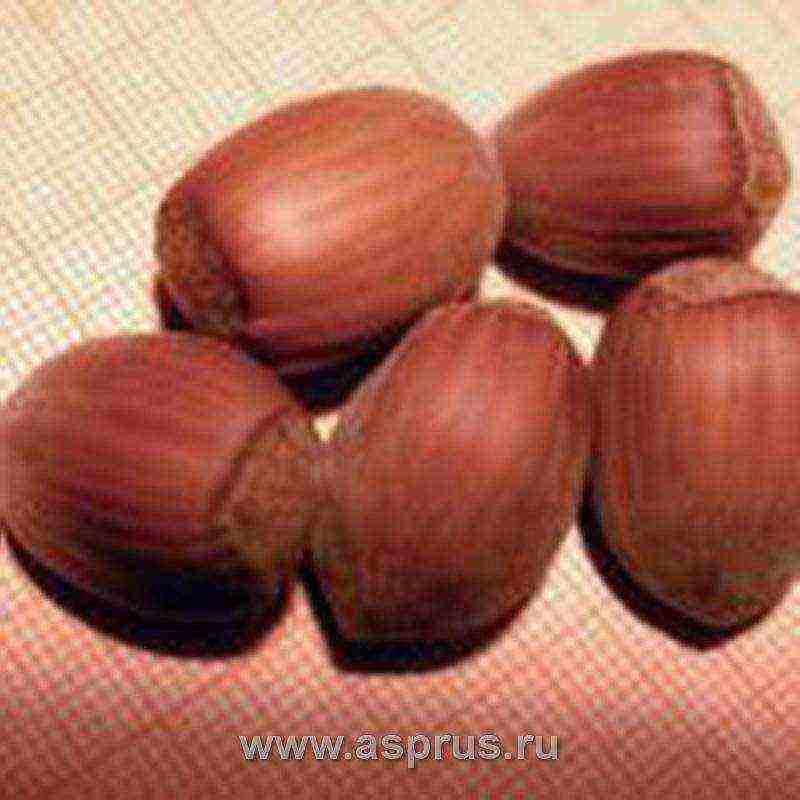
Cosford
Cosford variety of English origin, was first grown in Oxford in 1916. Large, slightly compressed bush, 5 m in height and 6 m in diameter, early fruiting, bears fruit very abundantly. The leaves are dark green, wide, oval or obovate, slightly rough, large (length up to 14 cm, width up to 12 cm), acquire a red tint in autumn. Earrings are numerous, long, flexible, light brown or brown. The flowering time is early to medium - early. The growth of the bush is strong. Nuts are large and medium in size, cylindrical in shape, collected in bunches of 2 - 3 pcs. The shell of the fruit is on a par with the nut. The shell is clear bronze in color with dark stripes, very thin. The kernel of the nut is large, completely fills the shell. Nuts are large, oblong, broadly elliptical, flattened and rounded at the ends, often with ribs. The base is convex, gray with teeth. Nuts ripen in the first half of September. The kernel yield is 49.7 - 54% of the total weight of the nut, oiliness is about 62 - 68.27%. They are used for fresh and dry food, as well as in confectionery production. Demanding to growing conditions, prefers to grow in a place protected from the wind with a warm microclimate, resistant to diseases and pests. Medium resistant to low temperatures. The great advantage of the variety is the ability to self-pollinate. It also perfectly pollinates many varieties: Galle, Chudo iz Bolwiller, Valuable Webb, Nottingham, etc. It is itself well pollinated with varieties: Galle, Lambert red-leaved.

Crimean
Crimean variety with a large rounded kernel and a thin brown shell.

Kuban
Kuban Spontaneous somatic mutant (clone) of the Cherkesskiy 2 variety. Obtained at the All-Russian Research Institute of Floriculture and Subtropical Crops. Medium ripening. Winter-hardy, high-yielding variety. The average yield is 24 c / ha, the maximum - 27 c / ha. Universal purpose. Shrub 3 m high with a drooping crown of medium density. The leaves are large, slightly elongated, dark green, wrinkled. Fruits are very large, with an average weight of 3.5 g, round, slightly flattened, slightly ribbed. The rind is of medium thickness, dense, smooth, slightly bumpy, shiny with a barely noticeable bloom. Kernel yield 48%, fat content 67%, protein 19%. Tasting score 4.6 points. Accepted for state variety testing in 1995. Included in the state register in 1999 for the North Caucasus region. Pluses: Winter-hardy, high-yielding variety.
Originator: FGUP ‘Ivantievskiy forest selection experimental and demonstrative nursery’, obtained from the NGO “Funduk” of the All-Russian Research Institute of Forestry and Mechanization of Forestry. Seedling from free pollination of the Moscow Ruby variety. Medium ripening. Winter hardy. The bush is medium, 3.5 meters high. The crown is of medium density, rounded, branches depart from the trunk at an acute angle. The leaves are large, smooth, shiny, pinkish-red, inversely ovoid. The average yield is 6.4 c / ha, the maximum - 11.6 c / ha. (1.1 kg from 1 sq. M). Universal purpose. Fruit weighing 2 g, slightly elongated, with a pointed tip. The rind is medium, smooth, with faint stripes, yellowish-brown. Kernel yield 51.8%, fat content 68.2%. Tasting score 4.5 points. State test since 1995.Included in the state register in 1996 for the Central, North-Western, Middle Volga regions, recommended for the Central (Bryansk region, Kaluga region, Moscow region, Ryazan region, Tula region, Vladimir region, Smolensk region), Central - black earth (Voronezh region, Kursk region, Lipetsk region, Oryol region, Tambov region), Northwestern (Leningrad region, Tver region, Pskov region, Novgorod region), Middle Volga (Penza region) regions. Advantages: Winter-hardy, productive, with good fruit quality.
Curl (Tombul, Kerasund small) Received at the North Caucasian Research Institute of Mountain and Piedmont Gardening. The bush of medium growth is spreading - drooping, reaching 3.6 m in height and 5.5 m in diameter. Leaves are broadly oval, tomentose on the underside, with large teeth in the upper part. Petioles and annual shoots are heavily pubescent with simple and glandular hairs. Fruits in bunches of 2 - 15 together. The envelope is whole, less often split on one side, tightly enclosing the nut and almost twice its length, with a strong gray tomentose and glandular pubescence at the base, dissected along the edge into shallow toothed lobes. Early ripening. When ripe, the edges of the wrapper curl up, which makes it easier to extract the nut. Nuts 15x14x12 mm; broadly oval, rounded, with a sharp apex, often ribbed and with a tuberous base. The shell is thin, dark brown, shiny at the base. Felt-pubescent on top, with dark longitudinal stripes. The yield of pure nuts (without plyusa) is 52 - 61%. The kernel (52.5%) is solid, tasty, contains 70.23% oil and 15% nitrogenous substances. Nuts ripen in late July - early August. Harvest up to 17 kg from one bush. Curl has valuable qualities: abundant yield, early ripening of nuts, high kernel yield and high oil content. Introduced into the industrial assortment of hazelnuts in the Caucasus. Accepted for state variety testing in 1995. Recommended for testing in the North Caucasus region. Pluses: High yield. Good taste. The shell is thin. Disadvantages: Small fruits.
Kunzemüllers Western European cultivar. The bush is vigorous. Nuts are large - 2.3 cm high, 1.9 cm wide and 1.7 cm thick, broadly oval, angular, with a large, slightly convex base. Weight of 1000 nuts 3310 g. Kernel 46%, fat content 69.75%. Nuts ripen in September. Harvest 10 kg of nuts per bush.
Resort Received at the Ukrainian Research Institute of Forestry and Agroforestry named after V.I. G.N. Vysotsky. Accepted for state variety testing in 1978. Recommended for testing in the North Caucasus region.
Kutkashen - Niji - 69 A variety of Azerbaijani origin, is a derivative of the Ata-Baba variety. The bush is vigorous, with a broadly spreading crown, has a high growth-forming ability, shoots take root easily. Differs in stable productivity, high yield of kernels and commercial quality of nuts. The average yield from one bush at the age of 17 is 6 - 7 kg of nuts (20 - 30 kg / ha). Among the disadvantages of the variety, it should be noted the average winter hardiness and insufficiently high resistance to pests and bacteriosis. Blooms in February - March. The variety is self-fertile, but it bears fruit better when grown with pollinator varieties: Ata-Baba, Bolwiller's Miracle or wild forms of common hazel. Begins to bear fruit at the age of 6-7 years. Nuts ripen in late August - early September. Forms 4 - 5 or more fruits in seedlings. Nuts of medium size (2.1 g), with a thin shell (0.7 mm), with a high kernel yield (up to 50.0 - 57.0%) and a fat content (up to 68.9%). Recommended for extensive production testing in all hazelnut growing areas.
Hazel No. 2a Highlighted at the All-Russian Research Institute of Forestry and Forestry Mechanization. The height of the bush is up to 4m. The nut is almost round, with a diameter of 17 - 18 mm, with a very thin shell.The amount of fat in the core is 65%.

Lozovskoy spherical
Lozovskoy spherical Zoned since 1989 in the Steppe and Forest-steppe. Medium ripening. The wrapper is shorter, equal to or slightly longer than the nut, whole or split from one side to the base, serrated. Nuts are almost spherical, 2 cm long, golden yellow with dark oblong stripes, weighing 2.1 - 2.5 g. The kernel yield is 50%.
Lombard White (Ladies Fingers) The bush is highly branched, 3-5 m in height and up to 6 m in diameter. Leaves are broadly oval or round, 6-12 cm long, 6-11 cm wide, with a short and sharp tip, twice serrate. Fruits 2-3, up to 8. Whole, tubular wrapper, 1.5 - 2 times longer than the length of the nut, cracking when ripe. Nuts are spiky, oval-oblong, flattened on wide sides, with a large convex base. Walnut 23x15-13 mm. The shell is thin, fragile, light brown. Kernel 53.4%, excellent taste, fat content 70.6%. The variety is fruitful. The nuts ripen in mid-August. Good pollinator. Resistant to diseases and pests. Under the conditions of Krasnodar, according to N.A.Tkhagushev, it will give low yields due to frost damage to the catkins. Does not give root offspring. Included in the industrial range of the Black Sea coast of the Caucasus and Crimea.
Lombard red An excellent commercial variety, very similar to Lombard White and differs from it in the shell of the kernel, which in this variety has a wine-red color with a purple tint and a pale terracotta stripe. Stamens with red-brown anthers. Small walnut. Kernel 53%, fat content 70.1%. Harvest - 5-8 kg of nuts per bush. The passage through a 13.2 mm sieve (small nuts) is 32.2 - 38.0%. The yield of the core from the residue on the sieve is 35.6%, which corresponds to the specification. The overall kernel yield is 51.6%, the highest yield of all ten samples, due to the very thin shell. The elongated shape of the walnut does not correspond to the specification, since it makes it difficult to process it on equipment (the walnut, together with the kernel, is split in half). After dehulling, the yield of the kernel from the batch of such a nut will be very low (a lot of scrap), which will not allow the production of roasted hazelnut kernels from the kernels of such a nut. The shape of the kernels of this variety does not contribute to this either. The quality of kernels is average: among the rejection indicators, there are rotten kernels - 0.2%, kernels with surface damage - 0.2% and dried kernels - 1.6%, but their number does not exceed the permissible values according to the specification for kernels. Taken together, these rejection rates will affect the reduction in the yield of the core during processing.
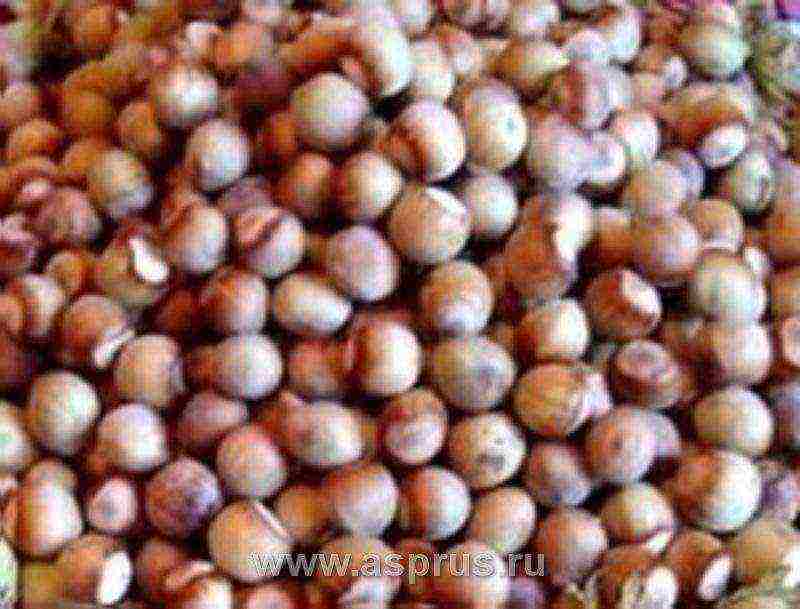
Louise
Louise Western European cultivar. The bush is quite vigorous. Fruits in bunches of 2 - 3, sometimes solitary. The envelope is short, up to or equal to half the length of the nut. Nuts are large, 25x19x23 mm. Weight of 1000 nuts 3.5 kg. There are no small nuts. The shape of the nut allows you to process (crush) it on equipment without significant losses. The core output is 45.31 - 45.6%, which is in line with the specification. Contains 61.63% oil and 8.68% protein. The quality of the kernels is average. Of the rejection indicators, there are dried kernels in the amount of 0.3%, kernels with surface damage - 0.3%, which corresponds to the specification and is subject to acceptance. The best pollinator of Nottinghsmskiy (39.6%), self-pollination - 14% of ovaries. Harvest 7 kg of nuts per bush.
Lviv A seedling from free pollination of a local Azerbaijani variety. Received from the Lviv Agricultural Institute. Medium ripening. Universal purpose. Bush 4.5 m high with a slightly spreading crown of medium density. The fruits are large, ovoid. The kernel output is 47.8%. Fat content 65.9%, protein 15.4%. A promising variety. Recommended for testing in the North Caucasus region.
Masha (hazelnut variety) A spontaneous hybrid obtained by R.F. Kudasheva from free pollination of the Tambovsky Ranniy variety hazel with red-leaved hybrid hazelnuts in the Ivanteevsky nursery VNIILM.Red-leaved variety Masha has elongated nuts, medium size, very thin shell, excellent taste. The variety is hardy and fruitful.
Almond-shaped Nuts are of medium size, weighing about 1.6 g. The shell is thin, light brown, shiny. The kernel is of medium size, tightly attached to the shell. The kernel yield is 45% of the total weight of the nut, oiliness is about 63%. The taste is very good, reminiscent of almonds. The nuts ripen in mid-August. They are used for fresh and dry consumption, as well as in confectionery production. The bushes are of moderate vigor with regular and abundant yields.
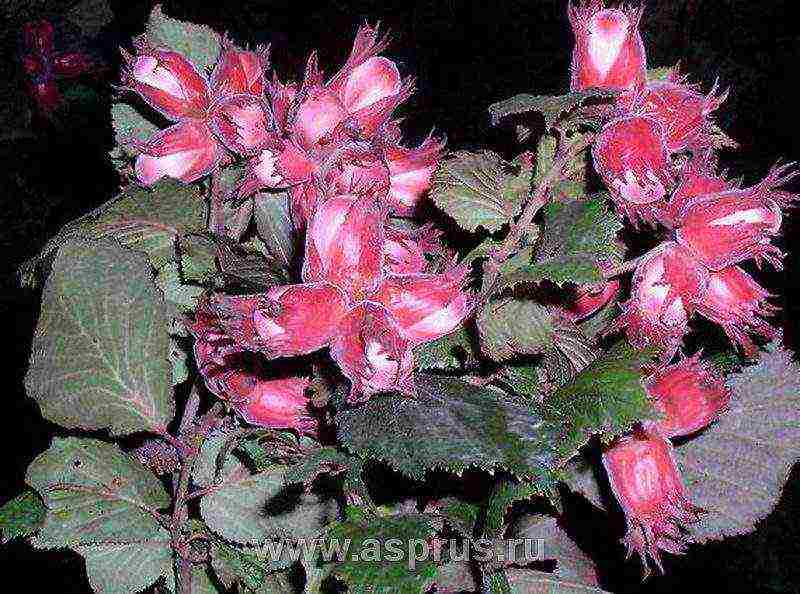
Moscow early
Moscow early (form I-4) Originator: "FGUP Ivanteevsky Forest Selekionny Experimental Demonstration Nursery". Selected form of common hazel. Received from the NPO for walnut growing "Funduk" of the All-Russian Research Institute of Forestry and Forestry Mechanization. Early ripening. Highly winter-resistant. The average yield is up to 6 c / ha., 0.6 kg from the 1st quarter. m. from a bush up to 3 kg. Universal purpose. A bush of medium vigor (up to 3.0 m) with a compact, slightly rounded crown. Leaves are red. Fruits of medium size (1.8 - 1.9 g) with shells of medium thickness, round-oblong, medium one-dimensionality, good taste. Kernel yield 50%, fat content 64%. Tasting score 4.5 points. Green-leaved forms are used as pollinators (Tambov early, Tambov late, Pervenets). State test since 1994. Included in the state register in 1995 for the Central, Central - Chernozem, North - Western, Middle Volga regions. Recommended for testing in Central (Bryansk region, Kaluga region, Moscow region, Ryazan region, Tula region, Vladimir region, Smolensk region), Central - Chernozem (Voronezh region, Kursk region, Lipetsk region, Oryol region, Tambov region), North - western (Leningrad region, Tver region, Pskov region, Novgorod region), Middle Volga (Penza region) regions. Pluses: Highly winter-resistant.

Moscow ruby
Moscow Ruby (VLM - 2) Obtained by crossing the Nottingheim variety and a mixture of pollen varieties. Received from the NPO for walnut growing "Funduk" of the All-Russian Research Institute of Forestry and Forestry Mechanization. Medium ripening. Winter hardiness is high. It is the main pollinator for hazelnut varieties, pollen fertility is 92%. Vigorous shrub up to 4.5 m high. Fruits are very large (3.5 g), wide-elongated, with a blunt top. Kernel yield 48%, fat content 63%. The kernel is delicate, with a dessert taste. Tasting score 4.3 points. State test since 1982. Included in the state register in 1994 for the Central, Central - Black Earth, North - West and North - Caucasian regions. Pluses: High winter hardiness. It is the main pollinator for hazelnut varieties.

Moscow ruby
Moscow Rubin Originator: R.F. Kudashev FSUE ‘Ivanteevsky forest selection experimental and demonstrative nursery’, obtained in 1957 (in the Zakatala nut farm of Azerbaijan) from pollination of female flowers of the large-fruited Azerbaijani variety Nottingheim with a mixture of pollen of four different red-leaved hazelnuts bred by A.S. Yablokova (Nottingheim x mixture of pollen of hybrid hazelnuts No. 154,155,162,167), selected from hybrid seedlings obtained by intraspecific hybridization. Already at the beginning of summer, the color of its leaves, plush, and the nut itself is bright crimson, and by the end of summer they become dark crimson. The bush is vigorous, up to 4.5 m high, winter-hardy, fruitful, in seedlings 7-8, and sometimes up to 15 large nuts, widely elongated, with a blunt top. Plusus equal to or slightly longer than nut, bivalve. In terms of average fruit length (28 mm), width, thickness, weight (3.5 - 3.8 g), it surpasses the variety Akademik Yablokov. The nuts are very large - 28 mm long, the shell is thin, smooth. The harvest is plentiful and annual.Nuts with dimensions of 28x18x16 mm (8x24x21 mm), the volume reaches 5 mm 3 with a thin and smooth shell. The kernel is in a smooth silky light shell, excellent taste. The shell of the nut is thin, the bottom is smooth, smooth and convex. The top of the nut is blunt, the top of the nut is slightly wider than at the base. Kernel yield 48-52%, fat content 63-64%. The kernel is delicate, with a dessert taste. Tasting score 4.3 points. The bush forms a lot of earrings - they are very dusty. Fruiting is annual, abundant. Fruits are wide - elongated with a blunt tip, large - up to 3.5 g. Vigorous bush, up to 4.5 m high. It is the main pollinator for hazelnut varieties, pollen fertility is 92%. The yield of the bush is 3 kg. Winter hardiness is high. In the Moscow region, the harvest ripens in early October. In the south, it is characterized by a later ripening period. A good pollinator for him is Tambovskiy early, Pervenets, Tambovskiy late. Recommended for Central, Central - chernozem, Northwestern and North Caucasian.
Find Seedling from free pollination of the form of the Sochi population. Received at the Ukrainian Research Institute of Forestry and Agroforestry named after V.I. G.N. Vysotsky. Medium ripening. Universal purpose. The bush is 2.5 m high with a rounded crown of medium density. The fruits are large (2.6 g), cylindrical or ovoid, without ribs. The kernel output is 50.5%. The fat content is 64.2%, the protein content is 14.9%. Tasting score 4.7 points. Accepted for state variety testing in 1983. Recommended for testing in the North Caucasus region.
Nemsa Local Georgian variety, distributed mainly in Guria (in Ozurgeti), in Samegrelo and in Lagodekhi (Georgia). The average yield is 18.2 c / ha. Recommended as a pollinator for varieties Khachapura and Cherkesskiy 2. A tall shrub with a spreading pyramidal crown. Ripens in mid-August. Fruits are medium (2.2 g), elongated, with a pointed tip, wide, yellowish base. The husk of the nut is whole, well removed when ripe. Shells are of medium thickness, 0.6-0.8 mm. The kernel yield is 50-52%, the fat content is 66-68-70%, and the protein content is 16.7%. The core of good taste. Accepted for state variety testing in 1954. Included in the state register in 1983 for the North Caucasus region (Krasnodar Territory and the Republic of Adygea).
Nottingham Western European cultivar. The bush is very vigorous. Fruits 2-9 together. Envelopes are fleshy at the base, glandular-pubescent, 1.5-2 times longer than nuts. Nuts are large, 24x16x12 mm, oval-oblong, flattened and slightly tapering towards the base. Weight 1000 nuts 1940 The shell is thin. Kernel 52%, tasty, fat content 72.33%, protein 10.17%. It begins to bear fruit in the 2nd or 3rd year after planting. The best pollinators: Eugenia 35% ,. Cosford 30%, free cross-pollination 32% of the ovary. With self-pollination, only 0.3% of the ovary is formed.
Olympic Seedling from free pollination of the form of the Sochi population. Received at the Ukrainian Research Institute of Forestry and Agroforestry named after V.I. G.N. Vysotsky. Medium ripening. Universal purpose. Shrub 3.6 m high with a crown of medium density. The fruits are large (2.5 g), cylindrical, without ribs. The kernel output is 47.2%. The fat content is 68.5%, the protein content is 20.3%. Accepted for state variety testing in 1983. Recommended for testing in the North Caucasus region. Pluses: Large fruits.
Palace Sprawling bush. The leaves are large, almost round or oblong, with a heart-shaped base and a large pointed tip. Along the edge in the upper part there are large lobe-like teeth. The underside is tomentose. Fruits of 2 - 4. Whole, tubular wrapper, about 2 times the length of the nut. The nut is spherical, slightly flattened from above, 1.5 - 1.7 cm long, 1.7 - 2.0 cm wide and 1.5 - 1.7 cm thick. The base is even or slightly lumpy. The shell is very thin, light brown, pubescent in the upper part. The kernel completely fills the shell, has a pleasant taste and contains 68.69% oil.The variety deserves a production test in the cultivars of the Crimea and the Caucasus.
Yablokov's memory (hybrid 328) (hazelnut variety) - hazelnuts, isolated in 1961 by RF Kudasheva from the hybrid fund of A.S. Yablokov, vigorous, large-leaved, frost-resistant, fruitful. The mother plant was a small-fruited, red-leaved hybrid hazelnut No. 86 (red-leaved hazel x Barcelona hazelnut). The father plant was the world's largest Turkish hazelnut variety - Trebizond (20x26x24). At a young age, this hybrid almost does not form male earrings, although nuts are tied early and abundantly on it. More mature bushes develop catkins, but they almost always freeze slightly, especially in winters with erratic temperatures. The number of germinating pollen grains reaches 92%. Female inflorescences have dark-burgundy, almost black stigmas, therefore, during spring flowering, it always seems that they are frozen, but by mid-June this impression is dispelled by the appearance of an abundant number of tied nuts. Compound fruits are densely crimson in color, with 7 - 12 nuts of the same color or even brighter than the plush. The nut wrapper is heavily pubescent with glandular hairs of a dark crimson color, monocotyledonous, with a slit towards the inner side, about 1.5 times longer than the nut, very fleshy. Nuts are large (26x16x14 mm), elongated in the form of an acorn. They are very different from the parent plant nuts. The nut shell is very thin - 0.8 mm, brown with darker longitudinal stripes ("zebra"), shiny, fragile, light, smooth inside. The apex is evenly narrowed, slightly pubescent. The bottom is convex, smooth, even, large. The kernel of excellent taste in a light, thin, silky film makes up 56% of the nut weight and contains more than 65% fat. In the conditions of the Moscow region, nuts ripen late (late September - early October). Excessively thin shells contribute to severe weevil damage to the nuts.
Panachesky Seedling from free pollination of the local form. Received from the Kuban State Agrarian University.
Firstborn (hybrid No. 1241) (hazelnut variety) Originator: received in 1957 by R.F. Kudasheva in F GUP ‘Ivantievsky forest selection experimental demonstration nursery’. An interspecific hybrid: a diverse-leaved Far Eastern hazel (C. heterophylla) and a large-fruited hazelnut mistakenly named Nottingheim (from the Zagatala nut farm of Azerbaijan), although its nuts in shape and size are closer to those of Sinclair and Gustav hazelnuts. Received at the All-Russian Research Institute of Forestry and Forestry Mechanization. Medium ripening. The yield is 8 - 10 kg / ha. (4 - 5 kg per bush). Earrings are reddish, like those of the mother plant, but they are much larger and abundantly dusty, collected in several pieces in the form of a brush. It is a good pollinator for red-leaved forms of hazelnuts, since it has a high viability (70 - 80%) of pollen and has an extended flowering period. The bark of the stems is gray. A bush of medium growth (up to 3.5 m) with a spreading crown. Gives a lot of growth at the very base of the stem. Leaves are red. The bunch consists of 2-5 large nuts, 27 mm long. The wrapper is carved, curly, the edges are bent outward, like a variegated hazelnut. It is 1.5 times longer than the nut, dicotyledonous, light green in color. The fruits are large, 27x21x18 mm (2.5 g), the volume of the nut reaches 4.5 cm 3, (in the hazelnut - 0.9 cm 3, in the father's nut - 3.5 cm 3). The shape of the nut is rounded - conical, elongated, similar to the shape of the father's nut, but larger. The shell is thin, even thinner than that of the southern hazelnuts. The surface of the shell is smooth, evenly colored in golden yellow color. The bottom is convex. The core is in a light, thin, silky film. Kernel yield 50%, fat content 65%. The flowering time of male and female inflorescences is the same. Female flowers have stigmas of bright crimson color. Male earrings are abundantly dusty, and the dusting period is longer than that of other hybrids.This is because they ripen at different times. Female flowers bloom at different times. This is very important to preserve them from short-term spring frosts, which, obviously, is the reason for the annual abundant harvest of nuts. The variety is recommended for breeding throughout the hazel range. It can be a good pollinator for many hazelnut varieties. Universal purpose. Tasting score 4.5 points. State test since 1975. Included in the state register in 1995 for the Central, North-West and North-Caucasian regions. Pluses: Highly winter-resistant. It is a good pollinator for red-leaved hazelnuts. The buds are not damaged at all by the hazel bud mite.
Restructuring Obtained by crossing the varieties Kudryavchik and Trebizond. Received at the All-Russian Research Institute of Floriculture and Subtropical Crops. Early maturing, green-leaved. Universal purpose. Sprawling - drooping bush 2.5 m high with a rounded crown of medium density. The fruits are large (2.2 - 2.5 g), round, slightly ribbed, yield 4 kg per 1 sq. m. The output of the core is 50%. Fat content 73%. Tasting score 5 points. Accepted for state variety testing in 1989. Included in the state register in 1999 for the North Caucasus region. Pluses: The highest tasting mark. Large fruits. Disadvantage: average frost resistance.
Pioneer 66 Ukrainian varieties of selection F. A. Pavlenko. Vigorous, spreading, densely leafy bush. At the age of 15, it reaches a height of 3.7 m and a diameter of 4.4 m. The buds are large, spaced, green. Leaves are dark green, often wrinkled, large, rounded or oblong, with a heart-shaped base, serrated along the edge, 7-12x5-10mm. Stipules are oblong - ovate. Petioles 1.5 - 2 cm long, glandular - pubescent. Fruits of 2 - 6. Envelope whole, less often dissected on one or two sides, almost one and a half times longer than the nut, open or slightly tapering above the nut, divided into shallow serrated lobes along the edge, glandular - pubescent. Nuts are round, slightly tapering towards the base, with well-defined longitudinal grooves. The base is large, convex, round or slightly quadrangular. The shell is light brown, shiny, soft pubescent at the top, medium thickness, loose. The nut is 2 cm long, 1.9 cm wide and 1.5 cm thick. The kernel is 50.8%, hard, covered with a light brown shell, sweetish in taste, fat content 62.83%. The variety reproduces well vegetatively. Nuts ripen at the end of August. Harvest 4.5 kg of nuts per bush.
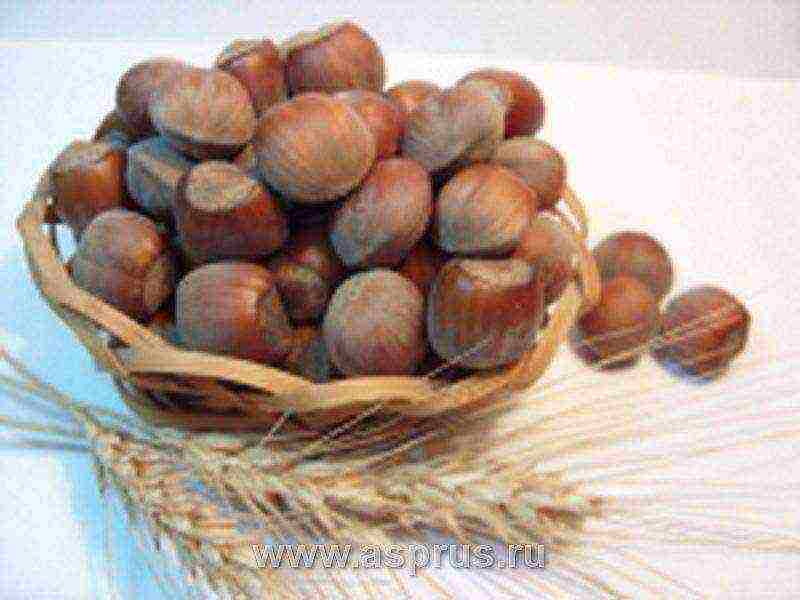
Pie
Pie Variety of selection of the UkrNII of forestry and agroforestry them. G.M. Vysotsky. The author is F.A.Pavlenko. Seedling from free pollination of the form of the Sochi hazelnut population. Medium ripening (in the zone of the northern forest-steppe of Ukraine, nuts ripen in the 2nd decade of August). Advantages of the variety: winter hardiness, high taste and technological qualities of nuts, unpretentiousness to soils and cultivation techniques. A vigorous, spreading shrub up to 4 m high with a rounded, sparse crown. Growth capacity is average. Suitable for standard culture. The yield in the 10th year after planting reaches 25 kg / ha. In fruit stems - from 3 to 5 nuts. The wrapper is short, almost does not protrude beyond the walnut, fits it loosely. Nuts are round, rather large, weighing 2.6 g, flattened from the sides. The shell is shiny, medium pubescent, bright brown with lighter stripes. Shell thickness is average (2.5 mm). Kernel content - 47% by weight of the nut. The kernel is round, slightly flattened, covered with a delicate skin, creamy, of excellent taste. The content of oil in the core is 66%, proteins - 15%. Universal purpose. Easily propagated by root shoots, vertical cuttings and green cuttings. Recommended pollinators: forest hazel, varieties Masterpiece, Stepnoy, Raketny. The variety has been included in the State Register of Plant Varieties of Ukraine since 1996.Accepted for state variety testing in 1981 (Russia). Recommended for testing in the North Caucasus region. It is promising for industrial and amateur cultivation in the steppe and forest-steppe zones of Ukraine.
Ukrainian varieties of selection F.A.Pavlenko. The bush is slightly compressed, at the age of 14 it has a height of 3.6 m and a diameter of 4.5 m. The buds are ovoid, green, ciliated, sometimes with a narrow brown rim on the scales. The leaves are wrinkled, inversely ovoid, oblong, with a heart-shaped base and an elongated cusp, up to 2 cm in length. The edges of the leaf blade are double-serrate-toothed. Leaf petioles 1 - 1.5 cm long, heavily pubescent with simple and glandular hairs. Fruits 2 - 8. Envelope 1.5 times longer than fruit, whole, rarely dissected on one or two sides, tightly covering the fruit, almost covering it from above. The pubescence of the envelope is strong, simple and glandular. The nuts are 1.7 cm long, 1.4 cm wide and 1.2 cm thick. They are oblong with an almost flat or slightly tuberous base and rather dense soft pubescence. The shell is fragile, of medium thickness, brown in color. The kernel fills the shell well, contains 62.1% oil. Nuts ripen in early September. Harvest 10 kg per bush. The variety is drought-resistant and frost-resistant. Recommended for industrial crops in the zone of ordinary chernozems of Ukraine.
Variety of selection of the Ukrainian Scientific Research Institute of Forestry and Agromelioration named after V.I. G. Vysotsky. The bush is of medium vigor, 3.3 m high, 4.3 m in diameter. It blooms in February - early April. The first to bloom are female flowers. The fruits ripen in mid-August. Fruits are collected in infructescences of 2 - 5 pcs., There are also single ones. Large, 2.4 g, elongated - conical, slightly compressed on both sides. The shell is light brown, shiny. Kernel yield - 43.7%, fat content - 75%. Average yield - 13.9 c / ha, maximum - 23.1 c / ha.
Ukrainian varieties of selection F.A.Pavlenko. The bush is spreading, at the age of 14 it reaches 3.2 m in height and 4 m in diameter. Annual shoots are densely covered with simple and glandular hairs. Buds are ovoid, 0.3 - 0.5 cm in length, green, ciliated, slightly pubescent; the lateral buds are spaced apart. The leaves are round, oval or obovate, with a heart-shaped base and a pointed apex, 8-10x5-7 mm. Leaf petioles 1 - 1.5 cm long, pubescent with simple glandular hairs. Fruits of 2 - 4, less often - one at a time. The envelope is divided on two sides, 2 - 2.5 times the size of the nut, along the edge it is divided into rather large non-toothed lobes with strong simple pubescence and sparse glandular hairs. Nuts are small, 1.5 cm long, 1.6 cm wide and 1.4 cm thick, round, with an even or slightly tuberous base and teeth. The shell is 1 mm thick, fragile, light brown, half pubescent. Kernel 53.3%, very tasty, fat content 66.25%. Nuts ripen in the second half of August and peel off easily. The variety is a good pollinator, resistant in the steppe part of Ukraine. Recommended in the industrial assortment of hazelnuts for Ukraine.
Originator: Botanical Garden - institute of the Ufa Scientific Center, universal, medium-early ripening period. The bush is weak, 2.5 m high. The crown is of medium density, oval. Shoots are medium, straight, pubescent. The leaves are large, rounded, slightly wrinkled. The color is red, later green. Fruits are medium, weighing 1.5 - 1.6 g, slightly ribbed. Kernel yield 52%. Tasting score 4.8 points. The shell is medium, dense. The surface is smooth. Average yield per tree is 3.5 kg. The method of propagation is vegetative (layering, green cuttings). The best pollinators: Tambov early, Pervenets. Features of the variety: good taste, original shape and color of fruits, with mild periodic fruiting, moderately resistant to nut weevil and earring gall midge. Winter hardiness is high. Included in the State Register of the Russian Federation for all zones of cultivation.
Variety of selection of the Ukrainian Scientific Research Institute of Forestry and Agromelioration named after V.I. G. Vysotsky. The height of the bush is 4 m, the diameter is 4.3 m. It blooms in February - early April. The first to bloom are female flowers. Nuts ripen at the end of August. Fruits are collected in seedlings of 2 - 6 pcs., Small, oblong. The base is gray, convex, uneven. The shell is light brown. Average fruit weight - 1.5 g. Kernel content - 44.7%, fat - 66%, average yield is 22.1 c / ha, maximum - 33.2 c / ha. Frost resistance - 37 ° С.
(form 344)
Originator: F GUP "IVANTEEVSKY FOREST SELECTION EXPERIMENTAL - INDICATIVE KENNEL". Obtained by crossing varieties F-86 (purple-leaved hazel and Barcelona) and Trebizond. Received from the NPO for walnut growing "Funduk" of the All-Russian Research Institute of Forestry and Forestry Mechanization. Early and medium ripening. Highly winter-resistant and highly drought-resistant. Average yield is 6 c / ha, maximum - 9 c / ha. (up to 3 kg per bush). It is a good pollinator for green-leaved forms. Universal purpose. A bush of medium growth (up to 3.5 m with a spreading, very decorative crown, branches branch off from the trunk at an acute angle. The leaves are large, obovate with a dark purple color. Fruits are small (1.3 - 1.5 g), oblong, obovate. Shells of medium thickness, smooth, shiny, with thin stripes. Kernel yield 45%, fat content 62%. Tasting score 4.6 points. On state testing since 1995. Included in the state register in 1997 by Northwest and Middle Volga regions.

Pushkin Red
Pushkin Red (Hazel variety) From a hybrid stock of red-leaved hazelnuts. Good for cultivation in personal plots and such a variety as isolated from Yablokov's hybrid fund. Its nuts are even larger. They are collected in the stem of 10 pieces. The variety is very hardy, high-yielding and very decorative. Ivanteevsky red and Pushkin red are similar to each other, like siblings. Both have burgundy foliage, but Pushkinsky has a little darker. And nuts in both varieties grow equally large: 27x23x17 mm. For private households, these hazelnuts are especially good, because they are very winter-hardy.
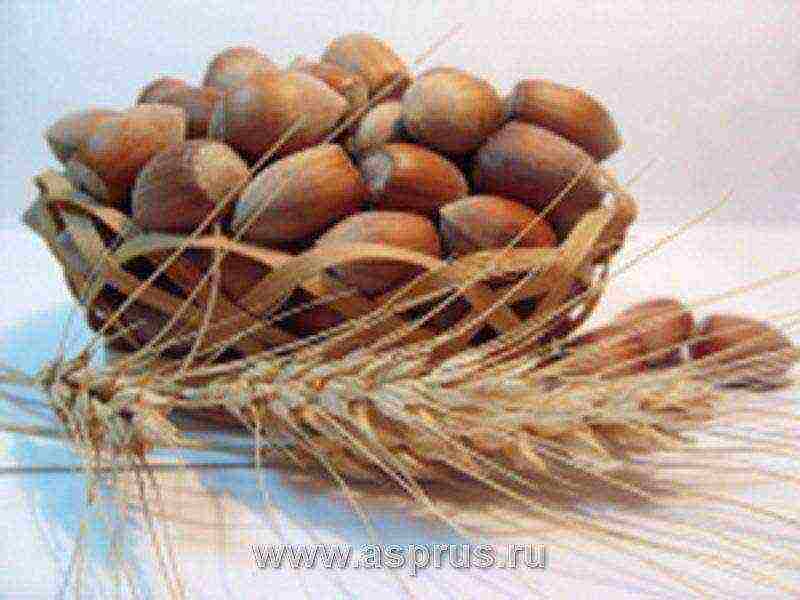
Missile
Differs in the compactness of the crown (bush height - 3 m, diameter - 3.5), winter hardiness of wood and generative formations, attractive fruits of excellent taste. The variety is of medium ripening (removable ripeness of nuts occurs in the third decade of August). Growth capacity is average, suitable for standard culture. Average yield - 5 kg of dry nuts from a 10-year-old plant. Nuts are collected in bunches of 3 - 7 pcs. The wrapper is twice as long as the nut, with a scalloped edge, tightly wrapped around the fruit. Nuts are cylindrical, acorn-shaped with a convex base and a pointed apex, of medium size (average weight - 2.2 g). The shell is shiny, slightly pubescent, of a beautiful light brown color, thin (0.8 mm). The kernel is elongated, easily cleaned from the film when ignited, creamy, excellent taste. The kernel output is 49 - 50%. The oil content in the core is 64%, proteins - 16%. Propagated by root shoots, vertical and horizontal layers. Recommended pollinators are forest hazel, Masterpiece, Borovskoy, Dolinsky. The variety has been included in the Register of Plant Varieties of Ukraine since 1990, and is promising for household and farm walnut growing in the steppe and forest-steppe zones of Ukraine.
Early Trebizond Nuts are large, oval in shape, with a pointed nose. The shell is thin. The seed is of medium size, tightly attached to the shell, with an easily peeled skin. The kernel yield is 54% of the weight of the nut, the oiliness is about 64%. Nuts ripen in the second half of July. They are used for fresh and dry consumption and also for processing. Bushes of medium vigor, early fruiting and are distinguished by regular and abundant productivity. The flowering period is early. The variety is self-fertile.
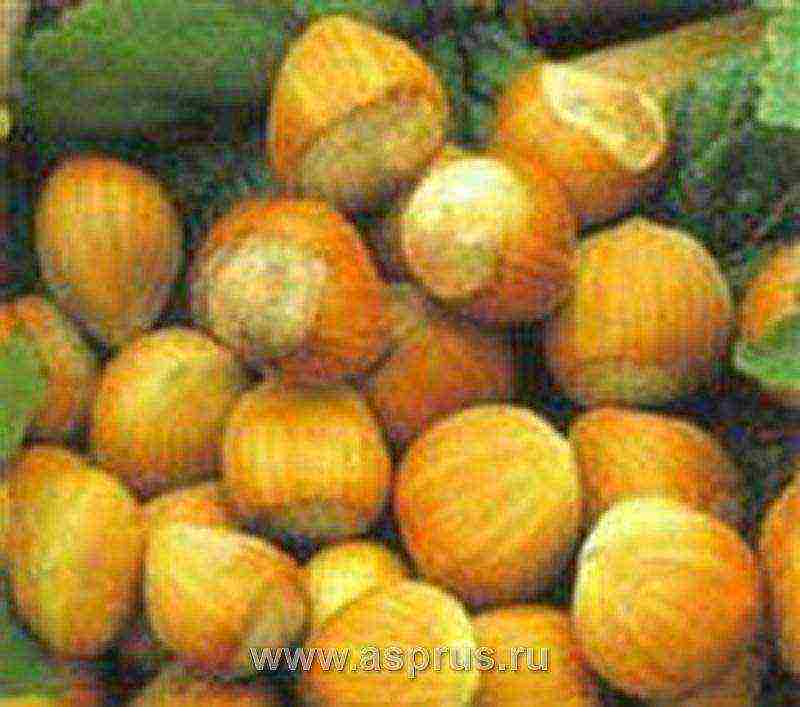
Roman
The nuts are large, weighing about 2.7 g. The shell is thin, light chestnut, with several grooves. The kernel is large and fits snugly against the shell. Kernel yield is about 46% of the total weight of the nut, oiliness is about 67%. The nuts peel off easily from the wrapper. Ripen in the second half of August. They are used for fresh and dry consumption, as well as in the confectionery industry. The bushes are vigorous, come into early fruiting, bear fruit regularly. An early flowering variety, self-fertile. Relatively resistant to disease. Obtained in Italy. Medium ripening. Resistant to pests and diseases. Weakly affected by powdery mildew. Average frost resistance. Average yield 30 - 35 kg / ha. Universal purpose. The shell thickness is 0.9 - 1.0 mm, the fat content is 68%, the protein content is 14.6%. Accepted for state variety testing in 1968. Included in the state register in 1973 for the North Caucasus region. Recommended for the North Caucasian region (Krasnodar Territory and the Republic of Adygea). Pluses: Resistant to pests and diseases. Weakly affected by powdery mildew. The fruits are large, with a beautiful appearance. Disadvantages: Average frost resistance.
Rode Zellernut (Common hazel) - This is an unusual modification of hazel. The main feature of this plant is the red color of the foliage. The leaves are rounded, decorative inflorescences (catkins) appear before the leaves open. Fruits are red, oblong, ripen in September - October. Plant height 6 m, crown diameter 4 m. Medium-sized, erect shrub. Grows moderately fast. Abundant fruiting.
Piano Western European cultivar. The bush is vigorous. Nuts in bunches of 2 - 4 together. The envelope is fleshy, whole, tubular, tightly covering the nut to the top. Nuts are of medium size (2.1 cm high, 1.4 cm wide and 1.2 cm thick), obovate, flattened. Weight 1000 nuts 1600 g. Kernel 54.8%, clean, well fills the shell, fat content 69.75%. It begins to bear fruit in the 4th year after planting. Nuts ripen in early September. Harvest 10 kg per bush. The passage through a 13.2 mm sieve is 66.0 - 70.0%. In this regard, the yield of the core from the rest on the sieve is very small - 19.2%, although the overall yield of the core is 50%. The shape of the nut is elongated, which will make it difficult to process it on equipment (the nut will split in half in the place with the kernel). After the shelling, the yield of the kernel from the batch of such a nut will be very low (a lot of scrap), which will not allow the most valuable type of finished product to be produced from the kernels of such a nut - roasted hazelnut kernels. The shape of the kernels of this variety does not contribute to this either. At the same time, the quality of kernels is good, the number of rejection indicators does not exceed the permissible values according to the specification for kernels. Unlike the previous sample, the sample of this variety contains dried kernels and kernels with surface damage, which, during processing, will affect a certain decrease in the yield of kernels. Damage to the surface of nut kernels affects the appearance of the finished product and may require additional costs for their bulkhead after roasting on a conveyor from this type of rejection.
Ruslanchik The nut is medium - small. The passage through a 13.2 mm sieve (small nuts) is 28.0 - 30.0%. The yield of the core from the rest on the sieve is 35.3%, which corresponds to the specification. The total kernel yield is 39.0%. The elongated shape of the walnut does not correspond to the specification, since it makes it difficult to process it on the equipment of the enterprise (the walnut, together with the kernel, is split in half). After dehulling, the yield of the kernel from a batch of such nuts will be very low (a lot of scrap). At the same time, the quality of kernels is good, from the rejection indicators there are only kernels with surface damage, but their number (0.2%) does not exceed the permissible values according to the specification for kernels (3.0%).
Red Majestic (Common hazel) - medium-sized, wide shrub, shoots and branches twisted in a corkscrew, with age, the crown is broadly spreading. 2 to 2.5 meters high and the same width. The leaves are wide-rounded, twisted, purple-red when blooming, later take on a green color. The men's earrings are also purple-red. Blooms until leaves appear. The fruits are red-brown, not very numerous and smaller in size than those of common hazel.

Sugary
Sugary From the hybrid fund of red-leaved hazelnuts, a hybrid red-leaved hazelnut with the varietal name Sugaristy has been allocated to the elite class for its high yield, winter hardiness and excellent quality of round, medium-sized, thin-shelled nuts. In terms of kernel yield, it is only slightly inferior to the Akademik Yablokov variety, but in terms of oil (71%) and sugar (16.9%) content it surpasses it. This hazelnut has a very intense dark cherry color of leaves, bush, and nuts (before removal from the bush). The harvest ripens in mid-September. Productivity and frost resistance are high. Obtained by crossing the variety F-86 (purple-leaved hazel and Barcelona) and Trebizond in the NPO for walnut growing "Funduk" In the Serossiysk Research Institute of Forestry and Forestry Mechanization. Medium ripening. Ripens in late August - early September. Winter hardiness is high. The average yield is 6 c / ha. (2 - 3 kg per bush). Universal purpose. A bush of medium growth (3 - 3.5 - 4 m) with a spreading, dense crown. Fruits are medium (1.6 - 1.8 g), medium one-dimensional, round. The main paint is golden brown, with slightly pronounced stripes, the kernel yield is 48%. Green-leaved forms are used as pollinators. Tasting score 4.5 points. Pluses: High winter hardiness.
Svitoch A seedling from free pollination of a local Azerbaijani variety. Received from the Lviv Agricultural Institute. Medium ripening. Universal purpose. Bush 4.5 m high with a spreading crown of medium density. Fruits are medium (1.9 g), round, without ribs. The kernel output is 52.6%. The fat content is 65.6%, the protein content is 16.5%. The tasting assessment of the taste of the kernel is 4 points. A promising variety. Recommended for testing in the North Caucasus region.
Severny 14 (Hazel variety) - hazelnuts of A.S. Yablokova (Ivanteevsky nursery), a hybrid from the same family. The bush is vigorous. The nuts are large - 22x22x18 mm, the plusa is equal to the nut, heavily carved. Shells are of medium thickness. The kernel yield is about 50%, the fat content is 65 - 66%. Collect 3-4 kg of pure nuts from the bush. Dessert variety. It can grow in Central Russia and in the south.
Severny 31 (Hazel variety) - hybrid hazelnut selection by A.S. Yablokova. Obtained in 1935 from a distant crossing - Barcelona hazelnut and Moscow hazelnut. This variety has smaller, rounded nuts. Walnut shells are of medium thickness, light brown in color, shiny. The kernel is in a thin film, its yield is more than 45%, the fat content in it is 70.5%. The variety is drought-resistant, vigorous shrub, reaches 5 m in height, the diameter of the main stem is 6 cm. The leaves are dark green, large. Earrings sometimes freeze under the conditions of the Moscow region, so a pollinator is required for this variety. The stigmas are colored bright crimson. The pollen has a viability of 95%. In the process of variety testing in the conditions of the Black Sea coast of the Caucasus at the age of 8 years, a crop of 3-4 kg of dry walnut from a bush was obtained. This variety can be bred in the Moscow region and in more southern areas.
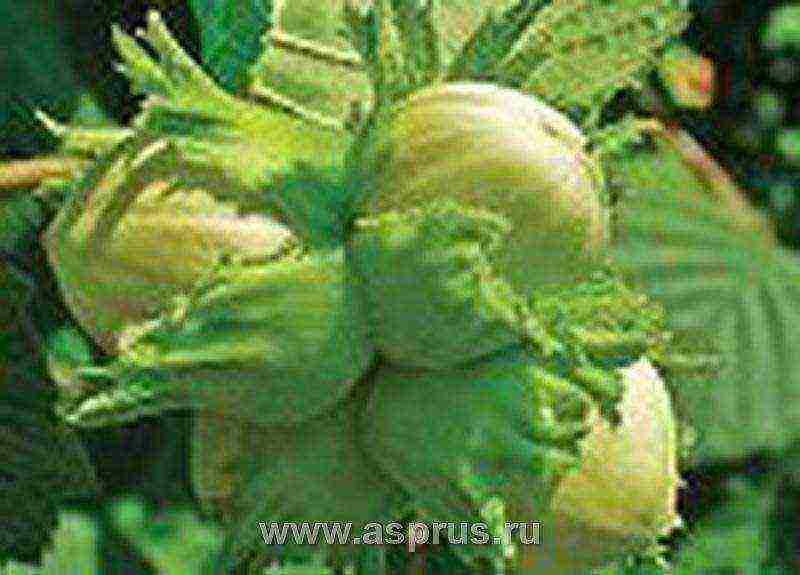
North 40
Severny 40 (Hazel variety) - hazelnuts of A.S. Yablokova (Ivanteevsky nursery). The bush is vigorous, winter-hardy. Fruiting annually, yield 3-4 kg per bush. The plus is equal to the nut, carved. Medium sized nuts - 18x18x16 mm, round. Shell 1 mm thick. Kernel yield 45 - 48%, fat content 65 - 67%. The variety can be cultivated in the middle lane.
Severny 42 (Hazel variety) - hazelnuts bred by Academician A.S. Yablokov.Obtained from crossing a juvenile variety (Barcelona hazelnuts) with hazelnut near Moscow, produced in 1935 in Sochi. Hybrid offspring were grown near Moscow. A winter-hardy plant, withstands the harsh winters of Central Russia and has nuts such as southern hazelnuts. In appearance, the nuts of this variety do not resemble those of the parent plant. They are large, but have an oblong shape, their size is 22x16x14 mm. Hazelnut North 42 inherited the paternal winter hardiness and good quality of the cultivated hazelnuts of the Barcelona parent hazelnuts. Nuts of this variety are dark brown, large, slightly flat. Their bottom is rounded, convex, smooth, even. The top of the nut is pointed. The weight of one nut reaches 2.5 g in the Moscow region and 3.8 g in the Caucasus. Kernel yield 47%, fat content 69%. Walnut shells are of medium thickness. The bush is vigorous, reaches a height of 4 - 5 m, the diameter of the main stem is up to 7 cm. The variety is a good pollinator. The ability to fertilize its pollen by the number of germinated pollen grains reaches 95%. The size of the pollen grains is 30 µm, the length of the pollen tubes when germinated in a 20% sucrose solution is 130 µm. The flowering time of male earrings and female inflorescences does not coincide. In the conditions of the Moscow region, male catkins sometimes freeze slightly; in industrial plantings, this variety needs pollinators. Female flowers - stigmas are painted in a dense - crimson color. The nut wrapper is single - and dicotyledonous, deeply cut, slightly exceeding the size of the nut. The variety can be bred in Central Russia.

North 9
Severny 9 (Hazel variety) - hazelnuts of A.S. Yablokova (Ivanteevsky nursery), obtained from the same parents as Severny 31 and at the same time. The bushes of this variety are vigorous, bear fruit every year. Under the conditions of the Moscow region, up to 3-4 kg of clean, dry nuts per bush are produced. Plusus is equal to or slightly longer than the nut. Nuts are large, oblong, slightly flattened. Shells of medium thickness - 1.5 mm. Kernel yield 48%, fat content 65 - 67%. The variety is winter-hardy. It can grow throughout the hazel range.
Silver Zoned since 1991 in the Steppe and Forest-steppe. Medium ripening. The wrapper is whole, twice as long as the nut, densely glandular - pubescent, sticky. Nuts are oblong - conical, with a large, slightly convex base, slightly ribbed, 2 cm long, weighing 2.5 g. The kernel yield is 47%.
Sickler Western European cultivar. The bush is vigorous. Nuts are large, ovoid, with a pointed top and a flat or slightly convex base. Weight of 1000 nuts 3.06 kg. Kernel 46.5%, fat content 64.88%.
Smolin (Hazel variety) The variety was obtained by R.F.Kudasheva from crossing a green-leaved hazelnut with a red-leaved hazelnut of Yablokov's selection (Ivanteevsky nursery). From the parent plant, he inherited the red color of leaves and nuts. The bush is quite vigorous, winter-hardy, fruitful, almost 5 meters tall. Nuts are medium in size, oblong in shape, very thin shell, delicate in taste. Collected in infructescences of 10 - 12 pieces.
Soviet 86 sprawling bush, multi-stemmed, densely leafy, almost spherical, reaches 2.2 m in height and 3.8 m in diameter at the age of 14. The bark on old stems is dark gray, on younger branches it is yellowish gray and on annual shoots it is greenish yellow. Buds ovoid, green, spaced, apical more obtuse, lateral - pointed. The leaves are dark green, oval or obovate, wrinkled, sometimes with sparse glandular hairs on top, 8-10 cm long and 6-8 cm wide, heart-shaped base, often funnel-shaped. The leaf blade is double-toothed, with a wide cusp. Petioles are short, 1 - 1.5 cm long, medium pubescent with simple and glandular hairs. Fruits are 2 - 4, rarely solitary. The envelope is dissected on two, less often on one side, slightly longer than the nut, at the base it is thick, wrinkled, open or slightly tapering above the nut, along the edge it is divided into wide serrated lobes with simple and glandular hairs.Nuts are oblong, slightly flattened on wide sides, with dense pubescence in the upper part, their length is 2.1 cm, width is 1.7 cm and thickness is 1.4 cm. The shell is light brown, shiny. The base of the nut is light gray, rounded - quadrangular, slightly convex or tuberous. The kernel is full, strong, with a light brown shell, pleasant taste and contains 60.29% oil. Recommended for industrial breeding in the southern regions of Ukraine.
Sochi 1 Spontaneous somatic mutant (clone) of the Cherkesskiy 2 variety. Obtained at the All-Russian Research Institute of Floriculture and Subtropical Crops. Late ripening. High-yielding. The average yield is 24 c / ha, the maximum - 27 c / ha. The variety is characterized by easy separability of the cupula from the pericarp, which makes it possible to mechanize the collection and processing of fruits. Universal purpose. Shrub up to 4 m high with a drooping crown of medium density. The leaves are large, elongated, dark green, slightly shiny, wrinkled, slightly pubescent. The fruits are large (2.8 g), round, slightly ribbed. The rind is of medium thickness, firm, smooth. Kernel yield 49%, fat content 68%, protein 19%, unsaturated fatty acids 89%. Accepted for state variety testing in 1995. Included in the state register in 1999 for the North Caucasus region. Advantages: High-yielding. Allows you to mechanize the collection and processing of fruits.
Sochi 2 Spontaneous somatic mutant (clone) of the Cherkesskiy 2 variety. Obtained at the All-Russian Research Institute of Floriculture and Subtropical Crops. Medium ripening. High-yielding. The average yield is 24 c / ha, the maximum - 27 c / ha. The variety is characterized by resistance to pests and diseases. Universal purpose. Shrub up to 4 m high with a spreading crown of medium density. The leaves are large, elongated, green, wrinkled, slightly pubescent. Fruits are large (2.5 g), slightly elongated, slightly ribbed. The rind is of medium thickness, dense, smooth, slightly bumpy, shiny. Kernel yield 49%, fat content 68%, protein 20%. Accepted for state variety testing in 1995. Included in the state register in 1999 for the North Caucasus region. Advantages: High-yielding. The fruits are large.

Stepnoy 83
Stepnoy 83 rather sprawling bush, reaches 3.5 m in height and 4.3 m in diameter at the age of 14. Leaves broadly oval or obovate, dark green, slightly drooping, with curled edges, 8-10 cm long, 6-8 cm wide, with a sharp tip 1.5 cm long. Leaves on young shoots are often funnel-shaped at the base. Stipules are elongated, with a wide base and a pointed apex. Petioles densely pubescent with glandular and simple hairs. The buds are ovoid, pointed. Fruits are 2 - 5, sometimes solitary. The envelope is fleshy at the base, glandular - pubescent, is equal in length to the nut or exceeds it by 1.5 times, whole or dissected on one side, along the edge it is divided into serrated lobes, slightly bell-shaped, due to which the nut is always open from above. Nuts are oblong, slightly tapering towards the base, shiny, with gray pubescence at the top and a large, almost round base. The shell is brown, with clearly visible darker longitudinal stripes, of medium thickness. The nut is 2 cm long, 1.3 cm wide and 1.2 cm thick, weighing 1.7 g. The kernel yield is 47%. The kernel has a high taste and contains 62.1% oil. Late ripening. Nuts ripen in early September. Harvest 8 kg of pure nuts per bush. The variety is recommended for the creation of industrial hazelnut orchards. Zoned since 1985 in the Steppe zone.
Tambov late (hazelnut No. 575) (Hazelnut variety) - Selected (RF Kudasheva) in 1956 in square 13 of the "Round" dacha of the Steppe forestry enterprise in the Tambov region. The height of the bush is 3.5 m, the diameter of the main stem is 3 cm, the number of stems is more than 200 in one bush. The stem bark is gray. The shape of the bush is spreading, the leaves are dark green, large. Nuts in fruit stems from 3 to 32 pieces.The plush is very small in the form of a cup, from the raw weight of the nuts it is only about 18%. Nuts of medium size 22x17x16 mm, slightly elongated, pointed towards the top. The bottom of the nut is wide, convex, smooth. The shell is thin, shiny, golden in color with dark longitudinal stripes. The nut is slightly pubescent towards the top. The kernel has a dark cherry smooth shell, sweetish, of excellent taste. The yield of the kernel in full biological ripeness is about 50%, the fat content is about 65%, the protein is 15.4%, and the sugar content is 12.5%. Late variety, high-yielding. The variety is more productive than the early Tambov. The yield is about 20 kg / ha. This variety is an excellent pollinator. The stigma is pale pink in color. In 1969 this variety was accepted for state variety testing. In industrial plantings, it can be used as the main one throughout the hazel range and beyond, and as a pollinator. Very frost-resistant, withstands frosts up to 42 ° C.
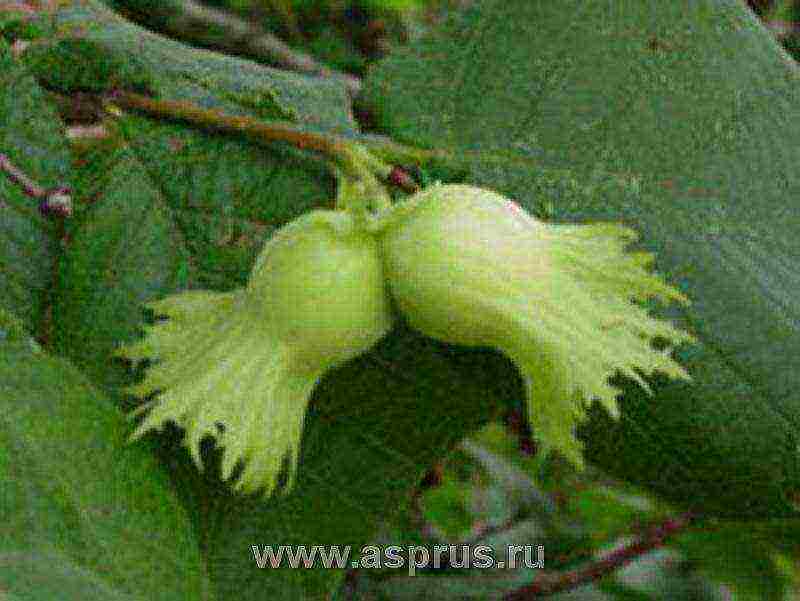
Tambov early
Tambov early (hazelnut No. 700) (Hazelnut variety) - accepted for state variety testing. Seedling from free pollination of the local form of common hazel, collected in natural thickets of hazel in the forests of the Tambov region at the dacha "Kruglaya" of the Steppe forestry enterprise in 1956 (RF K udasheva). Received from the NGO "Hazelnut" of the All-Russian Research Institute of Forestry and Forestry Mechanization. The height of the bush is 4 m with a narrow pyramidal crown, the diameter of the main stem is 3.5 cm. The leaves are large, light green, the shape of the bush is rather wide. A characteristic feature is too large a plus, which is not characteristic of common hazel, of two slices, almost 2 times longer than the nut and makes up 40% of the raw weight of the nuts. Nuts are oblong, golden yellow, average size 21 × 12 × 11 mm. Dessert destination. The shell is thin - 0.8 mm thick.
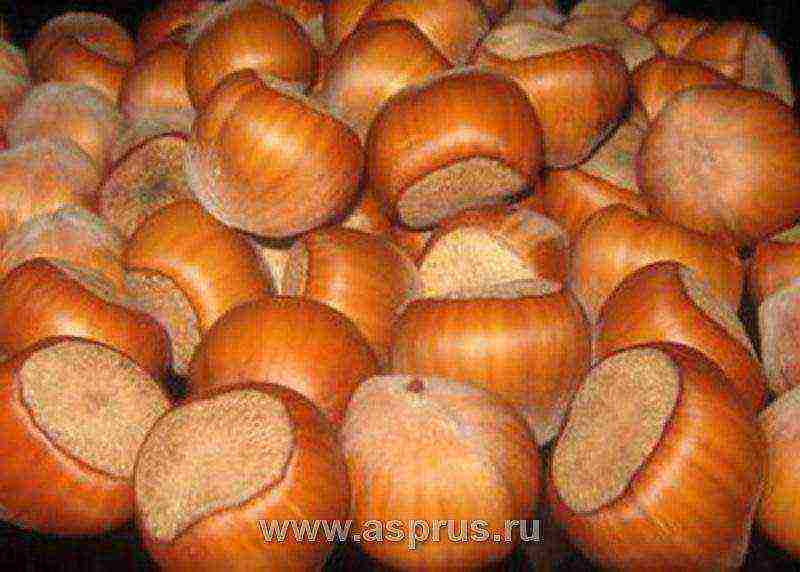
Trebizond
Trebizond meets modern international standards. This is how LP Simirenko described it: “… The walnut is very beautiful, very large, round, often tied alone, but more often in bundles of 3 - 5 pieces together. The drag is short. The kernel has a pleasant taste. The bush is very strong and fruitful. In Crimea, there are old bushes, the crown diameter of which is at least 5 - 6.5 m. Trebizond's frost resistance is 32C. Draw a conclusion from the following quote: "And today this variety is the main garden culture on personal plots in the villages of Sokolinoye, Aromatnoye, Orlinoye and others, which are located at an altitude of 500 - 700 m above sea level (northern slope of Ai - Petri), which is translated horizontal zoning (100 m vertically equal to 111 km horizontally) corresponds to the latitude of Lugansk, Kharkov, Vinnitsa. Thus, this variety is suitable for cultivation in the central regions of the country in the flesh up to Kiev, as can be seen on experimental plantings ”.
Ukraine 50 Ukrainian variety of selection F.A.Pavlenko. A vigorous, spreading bush, reaching at the age of 15 years a height of 3.7 m and a diameter of 5.2 m. The bark is dark gray, with a large number of lentils. The buds are oval or ovoid, obtuse, green, sometimes with a brown rim, ciliate. The dense dark green foliage gives this variety a high decorative effect. The leaves are large - 10 - 12 cm long, 8 - 10 cm wide, oval or broadly - obovate - ovoid with a point 1 cm long. The edges of the leaf blade are twofold - wide - toothed. Petioles and annual shoots have a rather strong glandular pubescence. On the wrapper and leaves, glandular pubescence is rare. The characteristic feature of this variety is the funnel-shaped base of the plate. Such fusion of the leaf blade is also observed on highly developed shoots of the varieties Furfulak, Sovetsky 86 and Stepnoy 83. Fruits are 2-4. nut, at the end it is bell-shaped - expanding. Along the edge it is divided into shallow, wide, almost triangular toothed lobes.The walnut is beautiful, round, rather large - 19 x 19 x 16 mm with whitish pubescence at the top and a large vaulted, gray, quadrangular base without teeth. At the top, there is almost always a speck with the remnants of an ovary. The shell is light brown, shiny, with visible darker stripes of medium thickness and quite easily cracking. The kernel is 47.4%, dense, excellent taste, fat content 62.9%. The variety is winter-hardy and drought-resistant, slightly damaged by pests and diseases. Nuts ripen in early September. Harvest 8.0 kg of nuts per bush. Recommended for creating industrial hazelnut gardens.
Harvest 80 a bush with a compressed crown, at the age of 14, the height is 3.8 m and the diameter is 4.2 m. Annual shoots have a strong simple and glandular pubescence. The buds are ovoid, 0.5 - 0.6 cm long, spaced, ciliate, slightly pointed. Leaves 6-8 cm long, 4-6 cm wide, oblong, obovate, with a shallow heart-shaped base and a sharp point 1 cm long. The edges of the leaf blade are serrate toothed. Petioles 1 - 1.5 cm long with abundant pubescence. Fruits of 3 - 8, sometimes up to 22. Envelope whole or dissected on one side, with an interception at the top, 2 - 2.5 times longer than the nut, tubular, tapering from above, with dense pubescence, along the edge is divided into shallow base, wide, in turn, sparsely toothed lobes. Nuts are small, 16x13x11 mm, oval, pointed, with a small convex or lumpy light gray base. The shell is thin, brown or light brown, softly pubescent in the upper part and with darker longitudinal grooves. The kernel is full, pleasant taste, contains 64.89% oil. Nuts ripen in the second half of August. Harvest 5 - 8 kg per bush. Recommended for industrial culture in Ukraine. On one bush there are 4-6 thousand catkins. If we take into account that one earring forms about 4 million dust grains, then the exceptional value of this variety as a pollinator becomes obvious.
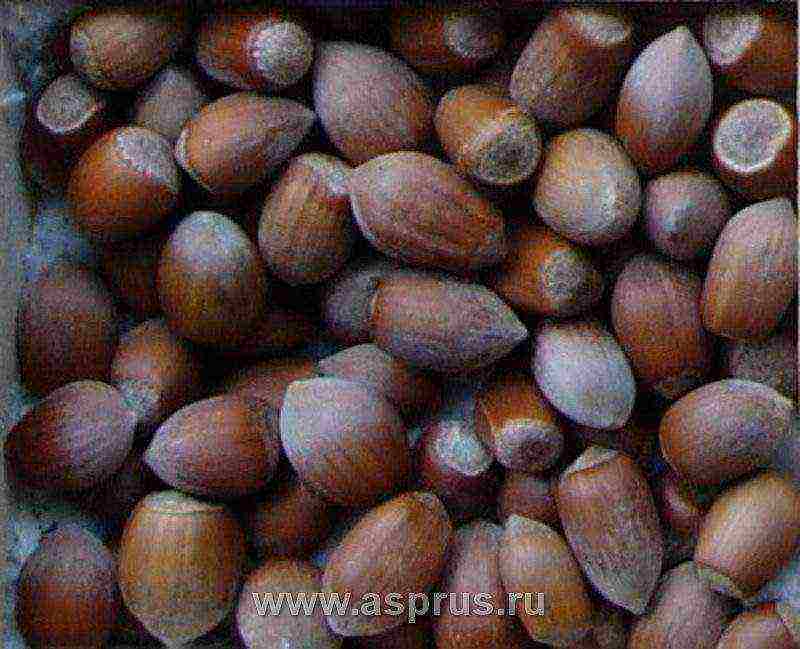
Hazelnut 42
Hazelnut 42 Ukrainian varieties of selection F.A.Pavlenko. A medium-sized, spreading, multi-stemmed bush, at the age of 15 it reaches a height of 3.5 m and a diameter of 3.8 m. The buds are large, green, ciliate. Stipules are ovoid, pointed. Leaves are oblong, sometimes asymmetrical at the base, with a large, 2 cm, pointed, serrate-toothed along the edge, often with glandular hairs on top, 7-12 cm long and 4-7 cm wide. Fruits 2 - 4. The envelope is dissected on one or two sides, 1.5 times the length of the nut, with sparse glandular hairs, fleshy at the base, open, along the edge is divided into shallow sharp-toothed lobes. Nuts are spherical, slightly flattened at the top from wide sides, with a large, slightly convex, almost round base. The shell is light - yellow - brown, shiny, soft pubescent at the top. Kernel 49.5%, completely fills the shell, hard, tasty, fat content 63.6%. Nuts ripen at the end of August. The variety is drought-resistant and frost-resistant. Recommended for industrial culture in Ukraine.
Furfulak (Trapezupd, Major) The bush is vigorous, spreading. The leaves are dark green, large - 8-14 cm long, 7-12 cm wide. On the edge twice - toothed, from below tomentose - pubescent. Fruits 2 - 5 each. The envelope is almost 2 times longer than the nut, whole, with an interception, fleshy at the base, pubescent with simple hairs and ends in large teeth - lobes. color base. Weight of 1000 nuts - 2.8 - 3.0 kg. Shell 1 - 1.25 mm, brownish, pubescent in the upper part. Kernel 44%, dry, solid, good taste, fat content 60.4%, 17% nitrogenous substances. Nuts ripen in early September. This variety has significant disadvantages: low kernel yield, large shrinkage during storage, susceptibility to nut weevil. Nuts of this variety are best sold semi-ripe, in a green wrapper.Considering all this, furfulak is not recommended to be introduced into new industrial plantations, but where there is a demand for green walnuts, small plantings of it can be profitable.
Futkurami Local Georgian variety. The originator is not registered. Early ripening. Highly drought resistant, not damaged by pests and diseases. The average yield is 17.6 c / ha. Self-fertile, the best pollinator is the Nemsa variety. Universal purpose. Sprawling, medium-sized bush that forms abundant root growth. Fruits are large (2.8 g), well-executed, round. The kernel yield is 50%, the fat content is 65 - 68%. Tasting score 4.5 points. Accepted for state variety testing in 1954. Advantages: Highly drought-resistant, not damaged by pests and diseases. Disadvantages: Self-fertile, forms abundant root shoots.
Halle The bush has great vigor. Nuts are very beautiful, cone-shaped, almost the same size, collected in bunches of 2 - 3 pcs. The shell is slightly longer than the nut itself, hiding it well. The shell is bronze, shiny with dark stripes, of medium thickness. The nut tastes good, almost completely fills the shell. The variety has an average yield, high after a year. Blooms in medium terms. Nuts ripen at the end of September and fall out of the shell themselves.
Kharkiv -3 Received at the Ukrainian Research Institute of Forestry and Agroforestry named after V.I. G.N. Vysotsky. Medium-sized walnut. The passage through a 13.2 mm sieve (small nuts) is 6.5 - 11.2%. The yield of the core from the rest on the sieve is 48.0%, which corresponds to the specification. The slightly elongated shape of the nut is out of specification (the nut will split in half with the kernel). After the shelling, the yield of the kernel from the batch of such a nut will be very low (a lot of scrap), which will not allow the most valuable type of finished product to be produced from the kernels of such a nut - roasted hazelnut kernels. The shape of the kernels of this variety does not contribute to this either. At the same time, the quality of the kernels is very good: all rejection indicators are absent, the mass fraction of moisture in the kernels is optimal - 3.98%. Accepted for state variety testing in 1977. Recommended for testing in the North Caucasus region.
Local Georgian variety, widespread in the regions of Guria, Adjara, Samegrelo and Lagodekhi, which was obtained by folk selection. The originator is not registered. The average yield is 30.2 c / ha. Universal purpose. Medium-sized bush with a dense spreading crown. Ripens in mid-July. Fruits are large (2.2 - 2.5 g), one-dimensional, broadly oval. It has a beautiful, flat shape and attractive color, wide base, thin and dark brown shell. The cover is a shell of medium thickness, reddish-brown, intact, 2 times the size of the fruit in a mature state, it is easily separated from the fruit (nut). The kernel output is 46.9 - 48%. The kernel is whitish, good taste, fat content 65 - 68%. Under high conditions, one bush yields 5.0 - 5.5 kg. Tasting score 4.2 points. Accepted for state variety testing in 1954. Advantages: High-yielding, large fruits.
A variety of Georgian origin. The bush is medium-sized, with a broadly spreading crown, the height reaches 4 m, the diameter is 5 m. It forms a lot of growth, but its rooting rate is not high enough. The variety is distinguished by regular fruiting, resistance to many pests and diseases, high tasting qualities of the fruit. The disadvantages of the variety are noticeable shrinking of the kernel during storage, insufficient winter hardiness. The average yield at the age of 16 is 17 - 20 kg / ha. Blooms in February - March. The flowering type is homogamous. The variety is self-fertile, at the same time it is itself a good pollinator. Begins to bear fruit at 6-7 years of age. Nuts ripen in August. Fruits are collected 2 - 4 per fruit. Nuts are large (2.7 g), with a thin shell (0.9 m), with a good kernel yield (up to 49.3 - 51.0%). The kernels have an almond flavor and contain up to 69.6% fat.Recommended for extensive production testing in various conditions of the southern hazelnut cultivation area.
A variety of Georgian origin. The bush is medium-sized, with a wide-spreading crown. Possesses high growth ability. Differs in average resistance to pests and diseases, relatively low yield and winter hardiness, cracking of the shell before ripening. Harvest at the age of 17 is 17 - 18 kg / ha. Blooms in February. Flowering type - Protandric. Fruits 6-7 years after planting. Nuts ripen early - in early - mid-August. Fruits are collected 2 - 4 per fruit. Nuts are large (2.9 g), with a thin shell (0.9 mm). The kernel yield is 49.6%, the fat content in the kernel is 68.8%. Recommended for extensive production testing in various conditions of the southern hazelnut cultivation area.
Tskhenis dzu-dzu this variety is widespread throughout Samegrelo, as well as in the Ozurgeti, Chokhataur, Lanchkhut regions of Western Georgia. This variety is favorably influenced by the humid subtropical climate. As for the eastern part of Georgia, this variety is common in Gori, Mtskheta and Lagodekhi. In Western Georgia, this variety ripens in mid-July, and in the eastern part in mid-August. The husk is the same size as the fruit itself, or slightly smaller. Reaching ripeness, the husk easily comes off the nut. The shape of the fruit is long, slightly wide at the base, characterized by a reddish-brownish tint. The fruit has a size of 24x16x10 mm. Weight ranges from 2.2 - 2.5 grams. The core is yellow, it fills the shell, the thickness of which reaches 0.9 mm. Kernel yield 54 - 56%, fat content 63 - 65%.
Circassian 2 Other names are Circassian round, Shapsugsky, Kerasundsky round, Kichmaysky, Adyghe. Local Adyghe grade. The originator is not registered. Early ripening. Average yield is 22.3 c / ha. It is characterized by relative resistance to pests and diseases. Relatively winter-hardy and drought-resistant. Universal purpose. A vigorous shrub with a spreading crown. Large enough. The passage through a 13.2 mm sieve is 1.2 - 2.0%. Fruits weighing 1.6 g, broadly oval, slightly flattened, pointed. The wrapper is whole, longer than the nut, divided into uneven toothed lobes. The shell is thin, brown, with slightly pronounced longitudinal stripes. The kernel yield is 50%, which corresponds to the specification, the fat content is about 70%. The shape of the nut allows you to process (crush) it on equipment without significant losses. The quality of the nut kernel is high: the moisture is optimal for roasting (4.45%), all types of rejects (rot, dried kernels, kernels with surface damage, live pests) are absent, which determines the high yield of the kernel. In terms of their shape and quality, walnut kernels correspond to the specifications for the production of such products as roasted hazelnut kernels. After roasting, the kernels of such nuts will have a uniform color and require less processing costs (bulkhead on the conveyor after roasting from the rejection indicators for the finished product). Tasting score 4.5 points. Accepted for state variety testing in 1950. Included in the state register in 1959 for the North Caucasus region. Recommended for the North - Caucasian region (Krasnodar Territory and the Republic of Adygea, Kabardino - Balkar Republic). Pluses: Relative resistance to pests and diseases.
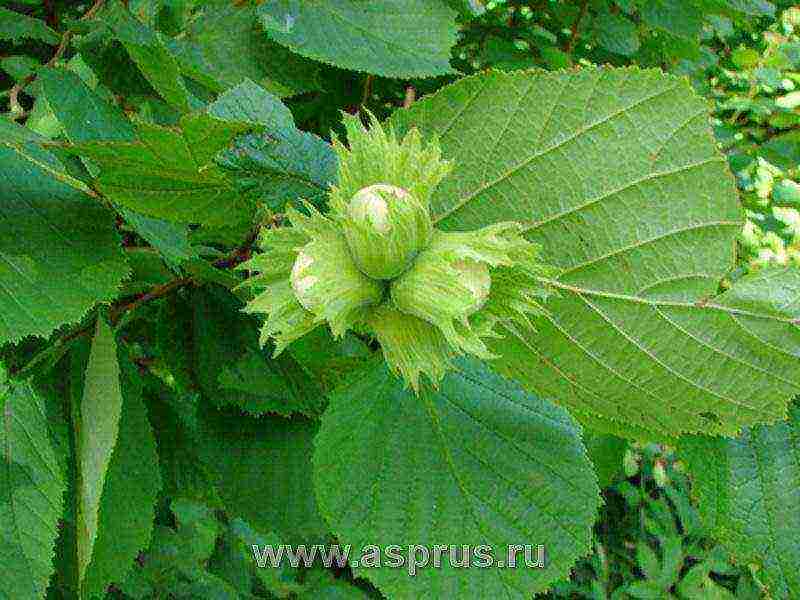
Circassian round
Circassian round (Circassian 2, Shapsugsky, Kerasundsky round Kichmaysky, Adyghe) A vigorous bush with a spreading crown, reaching 6 m in height and 7 m in diameter. Leaves are obovate with a heart-shaped base and a sharp tip, 6-12 cm long and 5-10 cm wide. Fruits are 2-5, sometimes up to 12. Whole wrapper, 1.5 times or slightly longer than the nut, pubescent, unevenly divided - serrated lobes. Nuts are round, broadly oval, slightly flattened and pointed, with a large vaulted light gray base, 18 -20 x16 - 18x12 - 16mm.The shell is smooth, thin, light brown in color, with inconspicuous dark longitudinal stripes, shiny at the base and densely tomentose pubescent at the top. Kernel 48 - 52% oily, strong, sweetish, fat content 69.7% - Relatively winter-hardy and drought-resistant variety. Nuts ripen in the first half of August. Yield 10 - 12 kg of nuts from a bush, and in especially favorable conditions - up to 18 - 20 kg. This variety is included in the group of industrial varieties for the regions of the Caucasus and Krasnodar Territory.
Bolwiller's miracle Western European cultivar. The shrub is of strong growth and has a high winter hardiness among the Zell hazelnut group. Leaves are oval, 10 - 12 cm long and 7 - 8 cm wide. Fruits one at a time, rarely 2-4. Envelope equal to or slightly longer than nut, divided from two sides to the base, dissected along the edge into serrated lobes by medium glandular hairs. The nut is beautiful, pointed - conical, pubescent at the apex, with a large, almost rectangular flat or slightly convex base, 20-25 x 20-23 x 20-22 mm. The weight of one nut is 3.5 g. The shell is light brown with darker longitudinal stripes, strong and rather thick. Kernel 43%, very tasty, fat content 61.7%. Ripening of nuts at the end of September, in October. The bushes of this variety are available at the Sochi, Sukhum and Maikop experimental stations, in many places in Latvia and Lithuania, as well as in Western Ukraine.
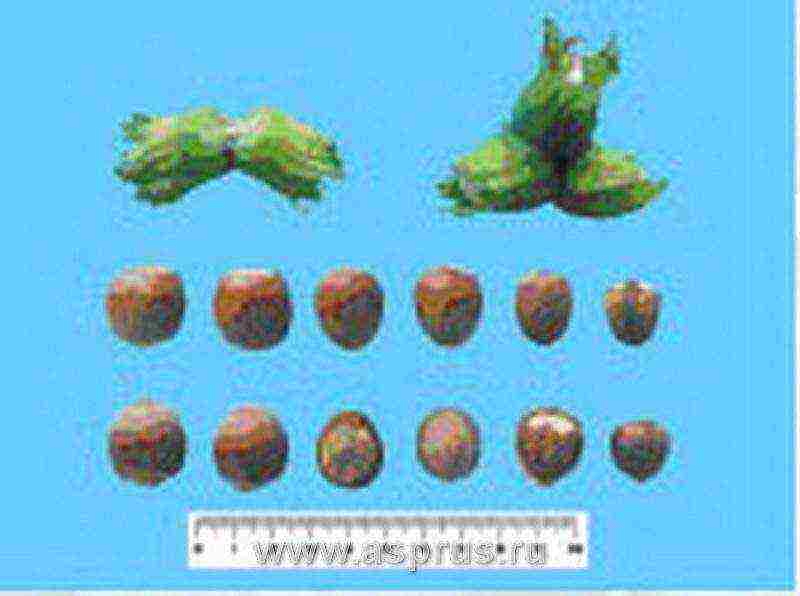
Shveliscura
Shveliscura mainly distributed in Guria, in the regions of Ozurgeti, Lanchkhuti, but in the Chokhataur region, it occupies a dominant role. In Megrelia, it ranks second and is widespread in the Zugdit region, where it is called "Square". The fruit bears fruit three years after planting. The harvest in western Georgia ripens in mid-July, and in Kartli (Eastern Georgia) 15-20 days later. The variety of this nut is characterized by a rich harvest, the average yield per bush is 5-10 kg. The husk is longer than the nut and wrinkled, it is easily removed from the fruit, the fruit is round and slightly longish, the base is flat, brown in color, from the base to the top is marked with a 1.0 mm thick strip. The fruit always fills the shell. The average weight of the fruit is 1.5 g. Kernel yield 49 -52%, fat content more than 63%.
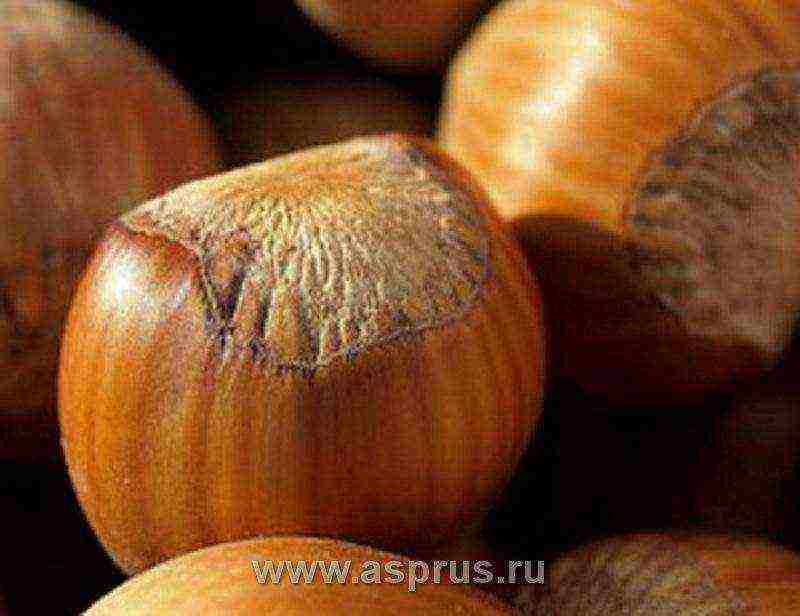
Masterpiece
Masterpiece One of the most valuable varieties of Ukrainian selection. Differs in high productivity, excellent taste and technological qualities of nuts. Winter hardiness of female and male fruit buds is above average. A variety of early middle ripening period - removable and consumer ripeness of nuts in the north of the forest-steppe zone of Ukraine (Kiev) usually occurs at the end of the second - beginning of the third decade of August. The bush is vigorous (up to 4 m), not prone to thickening. Low growth capacity allows the formation of trees in the form of a trunk. Fast-growing variety. The first harvest is formed in the 3rd year after planting in the garden. It quickly increases productivity: at the age of 7 it can yield up to 5 kg, and at the age of 10 - 8-9 kg of dry nuts from 1 tree. Nuts are collected in bunches of 2 - 8 pieces. The wrapper is twice as long as the nut, pubescent, the bunch looks very decorative. Nuts are large (average weight 2.5 - 3 g), 2 cm long, round with a pointed top. The shell is beautiful, dark brown in color, medium pubescent, of medium thickness. The kernel yield is 46 - 48%. The kernel is round, easy to clean from the film when ignited, good taste. The content of oil in the core is 65%, proteins - 17%. Propagated by root shoots, horizontal layering, green cuttings. Recommended pollinators: forest hazel, Cherkesskiy-2, Dolinskiy, Raketny, Borovskiy. The variety has been included in the Register of Plant Varieties of Ukraine since 1985, and is promising for industrial and amateur cultivation in the steppe and forest-steppe zones of Ukraine.
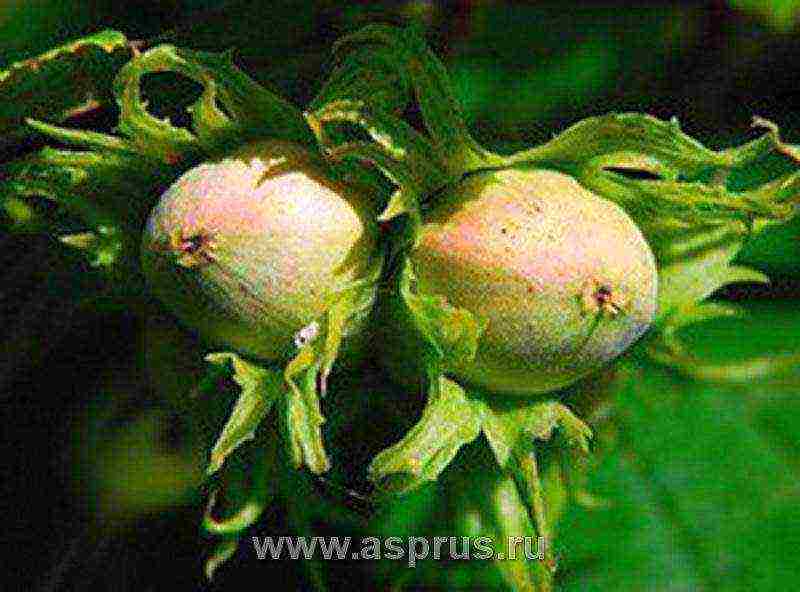
Chocolate
Chocolate variety of selection of the Ukrainian Scientific Research Institute of Forestry and Agromelioration named after G. Vysotsky.The bush is vigorous, slightly spreading, height - 4.5 m, diameter - 4.8 m. It blooms in February - April. The first to bloom are female flowers. Medium ripening. Fruits are collected in multiples of 2 - 4 pcs. The wrapper is slightly longer than the nut, strongly wrinkled, with strongly split ends. Nuts are oblong, short - cylindrical, dark brown, with darker longitudinal narrow stripes, 1.9 cm long, weighing 1.8 - 2.2 g. The kernel yield is 50%. The shell is dark brown with longitudinal stripes. The average yield is 16.2 c / ha, the maximum - 24.9 c / ha. Frost resistance - 37C.? Zoned since 1985 in the forest-steppe.
Jagles - hazelnuts (B3 / 7 - 3 / c). Bushes up to 12 m in height. Nuts are round, strongly pubescent in the upper part, 21x19 mm. The wrapper is 1.5 - 2 times its length. Nut weight 3g. The shell is thin. Kernel 48%, fat content 73%. The nuts ripen in early September. Diseases and pests are almost not damaged. This variety is distinguished by the Zakatala stronghold and is local, has nothing to do with the Turkish variety Kerasund round (or Yagly - hazelnuts), which is cultivated in Adjara, Abkhazia and the Sochi region of the Krasnodar Territory.
Hazelnuts are cultivated varieties of wild hazel or common hazel. It is a large shrub with a powerful branched root system. It grows as a multi-stemmed bush, forming many coppice shoots, which it reproduces. Hazelnut is a wind-pollinated monoecious plant. It blooms very early, sometimes at the end of January, and mass flowering begins in February-early March - before the leaf buds open. The hazelnut fruit is a nut covered with a plyus. It is useful because of the high content of vitamins, fats, proteins, carbohydrates. Not only nuts are useful, but bark, leaves, plus.

↑ to content ↑ The benefits of hazelnuts
Hazelnuts are tasty, healthy, nutritious. They contain 65-73% fats (oils), 18-22% proteins, 2-5% carbohydrates (starch and sugars). There are vitamins A, B, C, D, E, mineral salts. This determines its high calorie content as a food product. In terms of calorie content, hazelnut kernels surpass pork by 1.5 times, soybeans - 1.8 times, wheat bread - 3.5 times, beef - 3.8 times, chicken eggs - 4.5 times, potatoes - 8.5 times, apples - 15 times. For reference: 350-400 g of nuts satisfy the daily nutritional requirement of an adult.
The hazelnut kernel contains all twenty amino acids, from which complete proteins are formed. It retains its taste during storage even under normal room conditions. Nuts are easily absorbed by our body, no matter how they are cooked. This is an unsurpassed high quality product.
Hazelnuts have a lot of vitamin C in the roots and plyus of hazelnuts. Leaves and roots contain tannins.
In folk medicine, hazelnuts (hazelnuts) are used for urolithiasis, a decoction of dried plyusa - for diarrhea, bark - against fever, leaves - as an antiseptic.
Walnut, pounded with water, is used for hemoptysis, flatulence, bronchitis, and fever.
Chopped walnut mixed with honey is recommended for anemia, rheumatism.
A decoction of hazelnut bark, collected in spring, is used for malaria.
Walnut oil is an antihelminthic agent (for ascaris).
Crushed fruits mixed with egg white were used for burns.
Not only hazelnuts are useful. The bark has astringent, anti-dysentery, antipyretic properties. Bark infusions are used for varicose veins, varicose ulcers, and tumors.
Hazelnut (hazel) leaves are used to treat intestinal diseases, anemia, vitamin deficiency, rickets. Broth - with prostate hypertrophy. Ointment for cancer. Powder from dried plyusky or decoction of shells and plyusky - for colitis.
In early spring, beekeepers often harvest hazelnut or hazel pollen to feed young bees.This pollen is very useful for people: these herbal male genital products contain a lot of zinc, which is part of many enzymes that help solve the problem of infertility, making sperm motile.
↑ to content ↑ Healing properties of hazelnuts
And here are some popular recipes.
↑ back to contents ↑ Jaundice
Dry fresh leaves of hazelnuts or hazel. Pour one teaspoon of leaves crushed to a powdery state with a glass of white wine, leave overnight. Divided into three portions, taken daily before meals in three divided doses. After two weeks, the jaundice disappears.
↑ back to contents ↑ Varicose veins
- Collect hazelnut leaves in May. Pour 0.5 liters of boiling water over two tablespoons of leaves, leave for 2 hours. Drink half a glass 4 times a day before meals.
- Pour 0.5 liters of boiling water over one tablespoon of chopped hazelnut bark, cook for 10 minutes, drain. Drink half a glass 4 times a day before meals.
↑ back to contents ↑ Adenoma
Dry the hazelnut leaves collected in June in the shade. Pour one tablespoon of chopped leaves with a glass of boiling water. Heat in a water bath for 15 minutes. Drink 1/3 cup a day.
↑ back to content ↑ Biological features
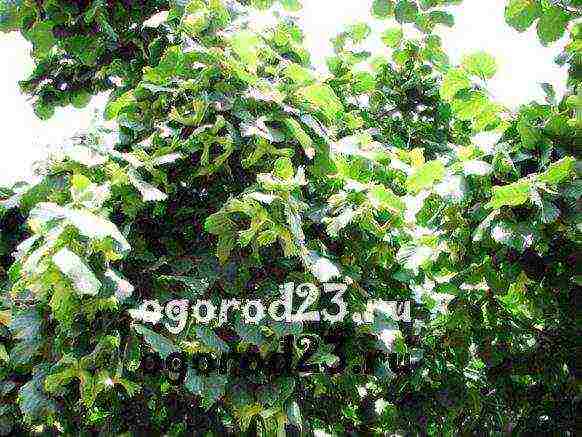

Hazelnut in February It is a relatively winter-hardy plant. We, in the Krasnodar Territory, did not notice freezing of hazelnut wood, although in the lowland areas there was frost damage to male inflorescences. When propagated by seeds, the plant does not retain the properties of the mother plant, and fruiting with this method of propagation occurs late.
Hazelnuts bear fruit well on sufficiently fertile soils provided with moisture. These can be flat areas or slopes. The southern slopes are not very suitable for growing it, since the buds here wake up too early - they can be damaged by recurrent frosts. Waterlogged, swampy areas are unfavorable for him. Hazelnuts grow well on light soils.
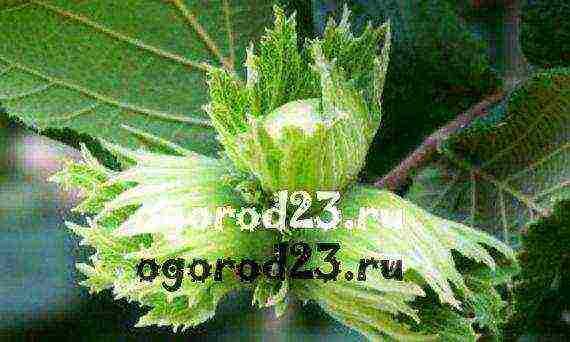 The fruit of a hazelnut is a nut covered with a wrapper - a plyusa. The mass harvest takes place at the end of August and the beginning of September. An indicator of the physiological ripeness of the fruit is the browning (yellowing) of the wrapper - plushi and the loss of individual nuts.
The fruit of a hazelnut is a nut covered with a wrapper - a plyusa. The mass harvest takes place at the end of August and the beginning of September. An indicator of the physiological ripeness of the fruit is the browning (yellowing) of the wrapper - plushi and the loss of individual nuts.
The need for hazelnut fruits is very high. The yield of nuts from one bush with a high agricultural background is 5-12 kg, in rainfed (arid) conditions on arable land - 3-5 kg, on unproductive - 2-3 kg.
In my country house, I collected a bucket of nuts from one bush in a good year.
Hazelnuts begin to bear fruit from 3-5 years with vegetative reproduction, from 6-10 - with seed. The greatest yields are obtained when it reaches the age of 12-35 years.
A hazelnut bush annually forms a large number (up to 100-150) of zero basal shoots. To obtain a high yield, the number of basal branches (trunks) must be maintained at the level of 8-10, but no more than 12 pieces per bush.
The longevity of the bush due to the intensive formation of rhizome growth is practically unlimited. In general, hazelnuts are immortal. Almost the life span of the bush is 150-180 years, without rejuvenation of the trunks - 60-80 years.
Thus, hazelnut bushes can live in one place for a very long time. But the soil is gradually depleted and compacted: diseases and pests accumulate; the regenerative capacity of plants decreases (the ability to form new zero shoots). A decrease in yield, drying of skeletal branches begins at the age of 20-25 years, and with irrigation, 5-10 years later. In the first case, the rejuvenation of the bush begins at 20, and in the second - at 30 years. During rejuvenation, the root branches (trunks) are replaced alternately, as they dry out, growing from the shoots instead.
Scientists have experimented a lot to increase the yield of hazelnuts. The decision did not come immediately. They began to plant seedlings every 1-2 m in a row. Then only those plants were left in which branches were naturally inclined downward. The rest of the plants were cut out.The lateral branches of the left seedlings were not removed, so their crown began at a height of 50 cm from the ground. The yield increased sharply to 40 kg / ha.
Probably, many experienced gardeners who have been gardening for a long time know: if a branch going up is tilted to the ground with a rope or a brick is hung on its end, the yield will increase dramatically.
↑ to content ↑ Hazelnut varieties
It is known that it is the variety that determines the level of plant productivity, the quality of the products obtained. It must be well adapted to local soil and climatic conditions. The following are considered the best varieties of hazelnuts in the south of Russia.
↑ back to content ↑ Variety "Adygeyskiy-1"
Fruits - average weight - 2.1 g, wide, rounded, collected in 3-4, less often in 5-8 pieces. Recommended for growing on farm, personal plots. The variety is winter-hardy, drought-resistant, fruitful. Hazelnuts of high taste. Medium resistant to pests, insufficiently resistant to bacteriosis. On the Black Sea coast, it produces from 5 to 10 kg of nuts from one bush. Begins to bear fruit in the 6-7th year after planting. The fruits ripen in late August - early September.
↑ back to content ↑ Variety "Ata-Baba"
The variety is medium-hardy. The crop gives annually. It bears fruit well. Nuts have an excellent presentation. Begins to bear fruit for 4 years. Average yield 9.5 c / ha. Universal purpose. A vigorous hazelnut bush with a spherical, slightly flattened crown. Fruits weighing 2.5-3.0 g, round, slightly elongated. The shell is of medium thickness, light brown with dark stripes. The wrapper is much longer than the nut. Resistant to major pests and diseases (except bacteriosis). The bush is very vigorous, with a rounded, slightly spreading crown.
↑ back to content ↑ Kavkaz variety
A selection variety of the All-Russian Research Institute of Floriculture and Subtropical Crops. Fruits are large, weighing 2.5 g. Feature: good separation of the nut from the cupule. It is a good pollinator. Deserves to be tested in all hazelnut cultivation zones. The shelf life of fruits under normal room conditions is up to two years.
↑ back to content ↑ Kuban variety
The variety is winter-hardy, with a high yield. Fruits are round, slightly flattened, slightly ribbed. The shell is medium, dense, smooth, slightly bumpy, shiny, with a barely noticeable bloom. Hazelnut fruits are very large, average weight - 3.5 g. Promising for growing in the Krasnodar Territory. Productivity - 8-9 kg from one bush (Black Sea coast). Suitable for mechanized harvesting.
↑ back to content ↑ Variety "Louise"
Promising for growing in the Kuban. Differs in increased resistance to low temperatures, regularly, bears fruit well (7-10 kg per bush). Gives nuts of high marketable, taste qualities.
↑ back to content ↑ Panaheskiy variety
Medium ripening. Fruits are large or medium-sized (2.2 g), rounded-oblong in shape. The wrapper is longer than the nut, whole, sometimes split on one side. Highly frost-resistant hazelnuts, relatively resistant to pests and diseases. The variety is recommended for cultivation in household or farm plots.
↑ back to content ↑ Sort "President"
Distinctive features: large-fruited, simultaneous ripening of fruits, the plyus is easily separated from the pericarp, which allows mechanizing the process of collecting nuts. Grows best on the Black Sea coast.
↑ back to content ↑ Roman variety
Fruits are large, weighing 3.2-3.5 g, one-dimensional, flat-round, with a beautiful appearance. It has a high potential for annual, abundant fruiting, is slightly affected by powdery mildew, kidney mites, and is moderately resistant to bacteriosis. The disadvantages of the variety include weak winter hardiness, low resistance to fruit rot. He was twice awarded gold medals at international exhibitions.
↑ back to content ↑ Cherkesskiy variety
It is characterized by relative resistance to pests and diseases. Relatively winter-hardy, drought-resistant.Universal purpose. Hazelnuts weighing 1.6 g, broadly oval, slightly flattened, pointed. The shell is thin, brown, with slightly pronounced longitudinal stripes. The main industrial grade on the Black Sea coast. It has proven itself well among amateur gardeners.
↑ to content ↑ Hazelnut processing
The nuts are harvested when they begin to crumble. They clean them of plush, store them in tight bags
The plyuska is also dried. You can cook jam from a green young plyuska, it has a pleasant sourness, syrups that help in the treatment of scurvy, loosening of the gums, impaired blood circulation, with increased pressure.
Hazelnuts are eaten raw, dried or roasted. From them you can make nut milk... To do this, fresh kernels are cleaned, crushed, soaked overnight in water, ground in a mortar. The resulting mass is diluted with a nine-fold amount of water, insisted for 4 hours, stirring from time to time. Then they boil, filter or drain the liquid part, adding salt and sugar to taste. By the way, nut milk turns sour and gives a delicious yogurt.
To receive nut butter crushed hazelnut kernels, slightly diluted with water, heated. The heated mass is wrapped in a piece of clean cloth, placed under a screw press, under which a vessel is placed to collect oil. It is not inferior in quality to almond, it is used in perfumery, confectionery, in the manufacture of high-quality artistic paints. Walnut oil has a light yellow color, pleasant smell, and is well absorbed by the human body. The dough with the addition of nut butter rises well, and the finished products do not stale for a long time.
Hazelnut kernels are often used to obtain vegetable cream, milk, and other products. To prepare nut cream, the kernels are peeled from shells, peels, crushed, ground, gradually adding water in small portions. The doughy mass is diluted with warm water, whipped until a homogeneous mass is formed, reminiscent of cream in taste. Store hazelnut cream in the refrigerator. Hazelnut cream is used in its natural form, it is used to prepare a delicious, nutritious cream for pastries, muffins, cakes.
Young leaves of hazelnuts are used as food for making stuffed cabbage rolls, soups and as a surrogate for tea.
The calorie content of a nut is much higher than that of beans, soybeans, raisins, figs, milk, and potatoes. Hazelnuts are widely used in the confectionery industry. Fillings for sweets and other confectionery products are made from nut flour and kernels. The cake remaining after the separation of the oil is processed for halva, chocolate, waffles.
↑ back to contents ↑ Recipes
Finally, a few recipes.
↑ to contents ↑ Nut cream for cake
Beat eggs and sugar until thick in a saucepan placed in a water bath, then cool, add pieces of butter, nut cream, grind thoroughly
Ingredients:
- eggs - 3 pcs.,
- butter - 150 g;
- sugar - 150 g;
- nut cream - 100 g.
↑ to content ↑ Nut drink
Pour the soaked, chopped nuts with water or milk for 4 hours, then strain. Bring the infusion to a boil, add salt and sugar to taste.
Ingredients:
- hazelnuts - 200 g;
- milk or water - 1 liter;
- sugar, salt - to taste.
↑ back to content ↑ Nut coffee
Fry hazelnuts, grind with a coffee grinder or mortar, add ground black coffee. Brew one teaspoon of the mixture with 200 ml of boiling water, bring to a boil, let stand and infuse. Add sugar to taste.
↑ to contents ↑ Nut tea
Boil one teaspoon of dried hazelnut or hazelnut leaves with 200 ml of boiling water. Insist 15-20 minutes Sugar - to taste.
Appearing much earlier than leaves, golden-yellow catkins of hazel are not only an early spring garden decoration, but also a source of pollen for bees. In summer, its dense foliage is a reliable protection from dust and noise, and in autumn they ripen delicious nuts - a delicacy for everyone.
Hazel - description of the bush
Common hazel (Corylus avellana) - very unpretentious, does not need special care and does not cause trouble for gardeners. It grows as a large multi-stemmed bush with an umbrella-shaped crown 3-5 m high. The thick light green foliage of the hazel in autumn is painted in golden yellow tones.
Fruits - brown nuts in a green leafy wrapper (plush), located 3-4 at the ends of the shoots. It takes about 5 months from pollination to fruit ripening. When ripe, the edge of the plush dries up and the nut falls out of the wrapper. The root system is powerful, fibrous, superficial.
Hazel bears fruit irregularly. Adult species of hazel give up to 3 kg of nuts per bush, varieties - 8 kg or more. The plant has a lifespan of about 60 years.
Hazel kernels are not only delicious, but also the most nutritious among the nuts. They have even more calories than fish and meat, and besides, about 70% of non-drying fatty oil, 16-23% of proteins, up to 8% of sugars, 3.2% of fiber, a lot of vitamins and microelements. The leaves and bark contain essential oils.
Hazel-based preparations treat skin diseases. The leaves are harvested in May. Their infusions are useful for liver and kidney diseases. Nuts pounded with water are taken for bronchitis, fever, anemia, rheumatism, as an antihelminthic agent.
Garden nuts - edible varieties
Cultural forms and varieties of hazel and the fruits themselves are called hazelnuts.
Large-fruited varieties of hazelnuts are successfully grown in central Russia. The average kernel yield is 48-52% of the weight of dry nuts.
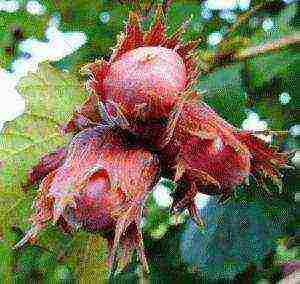 EKATERINA... Dessert variety, it can be grown with equal success in central Russia and in the south. The bush is vigorous, with red leaves, the color of the wrapper and nuts is from pinkish to dark crimson. The nut is long, large, the shell is thin. The puck is much smaller than the nut.
EKATERINA... Dessert variety, it can be grown with equal success in central Russia and in the south. The bush is vigorous, with red leaves, the color of the wrapper and nuts is from pinkish to dark crimson. The nut is long, large, the shell is thin. The puck is much smaller than the nut.
HYBRID No. 1 TLCA... Winter-hardy, green-leaved hazel, good pollinator for red-leaved forms. Perfect for the climatic conditions of the Central region of the Russian Federation. Bushes are undersized.
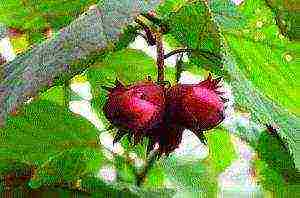 IVANTEEVSKY RED... A winter-hardy variety of medium ripening with large red leaves. Productivity up to 3 kg per plant. Good pollinator for green-leaved hazelnuts. A bush about 4.5 m high with a dense crown. Fruit weighing up to 2 g, wide ribbed, oblong. The shell is of medium thickness, smooth, with thin stripes, brown, light brown towards the top.
IVANTEEVSKY RED... A winter-hardy variety of medium ripening with large red leaves. Productivity up to 3 kg per plant. Good pollinator for green-leaved hazelnuts. A bush about 4.5 m high with a dense crown. Fruit weighing up to 2 g, wide ribbed, oblong. The shell is of medium thickness, smooth, with thin stripes, brown, light brown towards the top.
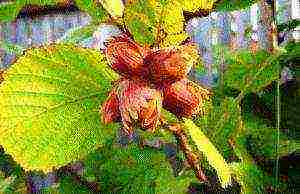 MOSCOW EARLY... A highly winter-resistant variety for universal use. Productivity up to 3 kg per bush. The bush is medium-sized (up to 3 m) with a compact, rounded crown. The leaves are red, the fruits are oblong, weighing up to 2 g. The shell is of medium thickness, the kernel is of good taste.
MOSCOW EARLY... A highly winter-resistant variety for universal use. Productivity up to 3 kg per bush. The bush is medium-sized (up to 3 m) with a compact, rounded crown. The leaves are red, the fruits are oblong, weighing up to 2 g. The shell is of medium thickness, the kernel is of good taste.
Green-leaved forms are used as pollinators (Tambov early, Tambov late, Pervenets).
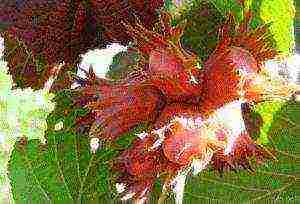 MOSCOW RUBY... Winter-hardy, productive variety. Already at the beginning of summer, the color of the leaves, plyus and the nut itself is bright crimson, and by the end of summer it is almost purple.
MOSCOW RUBY... Winter-hardy, productive variety. Already at the beginning of summer, the color of the leaves, plyus and the nut itself is bright crimson, and by the end of summer it is almost purple.
The bush is vigorous, up to 4.5 m high, in seedlings 7-8, sometimes up to 15 large nuts of a wide elongated shape with a blunt top. They are very large - up to 2.8 cm long, the shell is thin, smooth.
The kernel is in a silky light shell, excellent taste. Productivity from a bush is about 3 kg.
In the Moscow region, the harvest ripens in early October.
 TAMBOVSKY EARLY... An early ripe winter-hardy variety. Bushes up to 4 m high. Nuts are oblong, weighing about 2 g. Productivity up to 2 kg per bush. The variety can be propagated by nuts, the seedlings retain all the characteristics of the parent plant.
TAMBOVSKY EARLY... An early ripe winter-hardy variety. Bushes up to 4 m high. Nuts are oblong, weighing about 2 g. Productivity up to 2 kg per bush. The variety can be propagated by nuts, the seedlings retain all the characteristics of the parent plant.
MEMORY YABLOKOV... Late fruitful variety. Compound fruits are crimson, with 7-12 nuts of even brighter color than the plush. The nut shell is heavily pubescent with dark crimson glandular hairs.
Nuts are large, elongated, similar to acorns. The shell is very light and thin - about 1 mm. It is brown with dark longitudinal stripes, shiny and smooth inside. Nuts are easy to chop, but such a fragile shell is a weevil's dream.
The kernel of excellent taste in a light silky film, large - up to 56% of the weight of the nut. In the conditions of the Moscow region, the nuts ripen by the beginning of October.
 THE FIRST BIRTH... An interspecific hybrid of the Far Eastern variegated hazel (C. heterophylla) and large-fruited hazelnuts. Medium ripening. Productivity 4-5 kg per bush. Shrub up to 3.5 m high with a spreading crown. Gives a lot of growth. Leaves are reddish in color. The bunch consists of 2-5 large nuts about 2.5 cm long. The shell is thin, smooth, golden-yellow in color. The flowering time of male and female inflorescences is the same. Good pollinator for many varieties and red-leaved hazelnuts.
THE FIRST BIRTH... An interspecific hybrid of the Far Eastern variegated hazel (C. heterophylla) and large-fruited hazelnuts. Medium ripening. Productivity 4-5 kg per bush. Shrub up to 3.5 m high with a spreading crown. Gives a lot of growth. Leaves are reddish in color. The bunch consists of 2-5 large nuts about 2.5 cm long. The shell is thin, smooth, golden-yellow in color. The flowering time of male and female inflorescences is the same. Good pollinator for many varieties and red-leaved hazelnuts.
Hazel planting and care
Hazel prefers fertile, moderately moist soils. It is better to plant it along the borders of the garden plot in early spring or autumn. Planting scheme 3 × 3 m. 3-5 bushes are planted for reliable pollination.
When planting under the roots, it is very good to add some soil from under the old hazel. It is rich in mycorrhiza developing on the roots of hazel, with this addition the seedlings will quickly take root.
Young plants are watered as the soil dries up. For adult bushes, a lack of moisture in the middle of summer is dangerous, when the fruits are poured and flower buds are laid. In the process of leaving, the trunk circles are finely loosened and mulched. Once every 3 years, manure or compost is applied under the bushes.
Hazel blooms in April, long before the leaves bloom at a temperature of 12-15 ° C. The flowers easily tolerate frosts down to -5 ° C. They are dioecious, very small. Male ones in long inflorescences - earrings, throwing away scattering of yellow pollen from a snap of a finger. The female ones are hidden in pairs in globular buds, of which only reddish stigmas of pistils protrude during flowering. Pollination is carried out by the wind. On the same plant, male and female flowers bloom at the same time, therefore, several plants must participate in pollination.
Pruning
When forming a hazel bush, 6-8 trunks are left growing in different directions from its middle. In order not to change the natural form of growth, adult hazel bushes are cut off only when the crown thickens, while removing old and drying out branches as close as possible to the soil surface. Old bushes are subjected to strong anti-aging pruning, which is carried out in early spring.
When growing hazel in the form of a tree, one stem is left at the seedling, a stem with a height of about 60 cm is laid on it, and as it grows, 4-5 skeletal branches are formed. Root shoots are periodically removed.
In nature, there are fruitful forms of hazel, with good quality fruits, suitable for transfer to the garden plot. You should not dig up the entire bush, since you cannot count on a 100% survival rate. For transplantation, take root shoots or root a conveniently located branch on the spot by layering.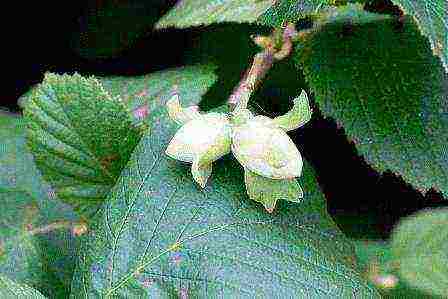
Reproduction
Non-varietal forms of hazel are propagated by seeds. For growing seedlings, only well-ripe, undried nuts are used. Autumn sowing is preferable to avoid stratification. The nuts are buried in fertile soil to a depth of about 8 cm.
For planting, two-year-old seedlings are used. They begin to bear fruit in the 5-10th year, and plants from vegetative propagation in the 4-6th year.
Hazelnut varieties are propagated only vegetatively: by layering of leafy shoots at the beginning of summer, by root shoots, which have to grow for 2 years, by dividing the bush, grafting and budding. Two-year-old seedlings of common hazel are used as a stock.
When propagating by cuttings, the best time for cutting apical cuttings is the beginning of summer. Leaves are removed from the lower half of the cuttings, about 20 cm long, the cuts are renewed, powdered with root roots and planted in containers with a light substrate. Care for the cuttings is normal. In winter they are kept in a frost-free room, in spring they are planted in open ground.
Harvesting
The nuts are harvested in September when they begin to crumble.The collected fruits are dried for 15-20 days in a dry ventilated area, stirring occasionally. After drying, the cups are easily separated.
Poorly dried nuts are not stored for a long time - the kernels rot. Dried fruits are stored in an air-permeable container. They do not lose their qualities within 2-3 years. Immediately before consumption, the nuts are roasted - the famous "hot nuts". Empty duck and shells are good for mulching.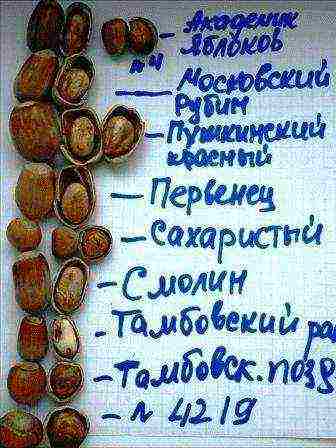
Hazel's fruit is large, but in nature it has personal distributors - squirrels. Every autumn, the animals hide hundreds of nuts, some are forgotten, and they sprout. This is how walnut groves appear.
Decorative forms of hazel
In landscape design, hazel is used in free-growing hedges, in groups on lawns, under the crowns of large deciduous trees. A green screen made from these plants will protect the site from wind and noise. Combines well with male dogwood, blackthorn and elderberry.
GOLDEN HAZEL AUREA (AUREA). Slowly growing bush up to 6 m high. Leaves when blooming are golden-yellow, later greenish-yellow, golden in autumn. The fruits are edible.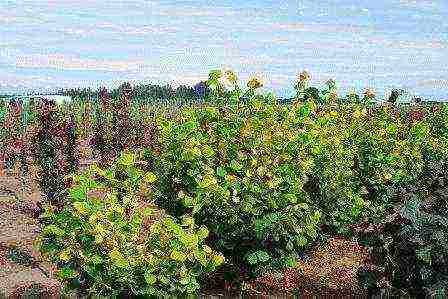
KONTORT ROCK HAZEL (CONTORTA). The form of common hazel with twisting strongly twisted shoots, wrinkled leaves and oblong nuts. Suitable for single plantings in a conspicuous place, the plants are spectacular in winter with bare branches. The bushes grow slowly, with a maximum height of about 5 m.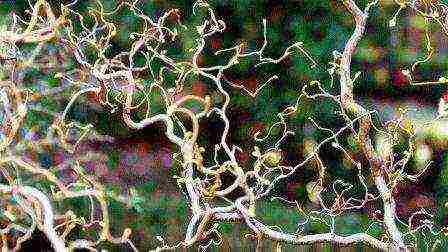
The bizarre shape of the corkscrew hazel is preserved by regularly cutting out the straight shoots appearing from the root collar. It is best to keep only a few of the most expressive branches.
RED-LEAVED FORM (ROTBLATTRIGE ZELLERNUSS). Sprawling bush up to 5 m high. The leaves are dark red, later red-brown. A purple-leaved decorative form is known.
Household use
Hazel has long, slender stems covered with gray-brown smooth bark, and a lot of root growth. The flexible young shoots of hazel can be easily cut into long twigs for use in weaving. If in the old days wattle fences and pens for animals were made of hazel, now it is more often used for hedges.
The saying "To cut into a nut" means to do the job thoroughly. Each line of the pattern of beautiful hazel wood seems to be drawn with a thin feather. It is perfectly polished and used for making musical instruments, weapon parts, walking sticks. It makes excellent handles for knives and garden tools. Special charcoal is also burned out of wood for drawing. But the bark is used in the leather industry.


